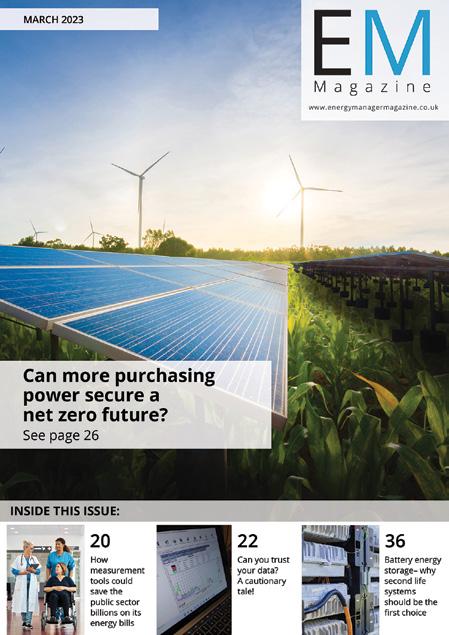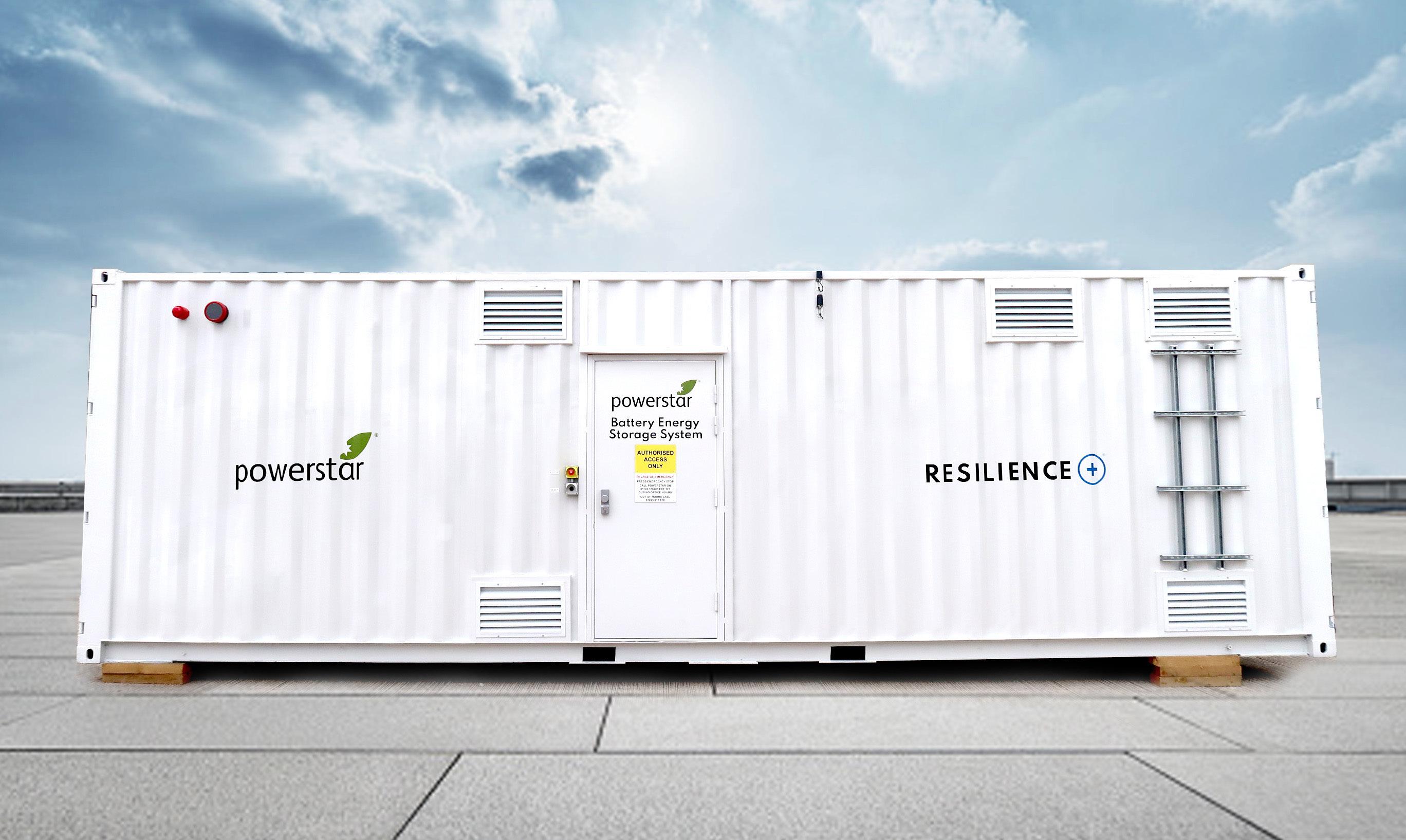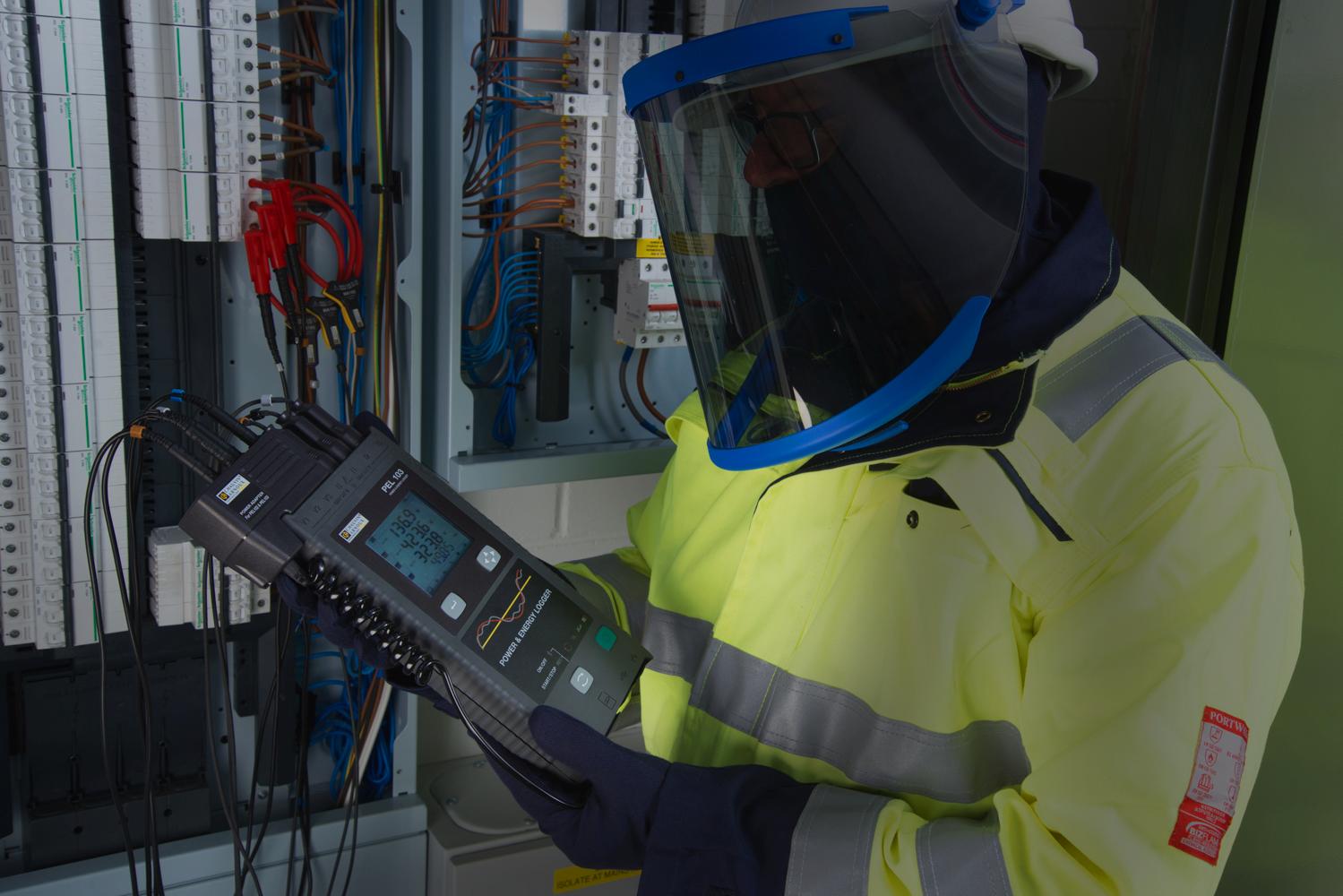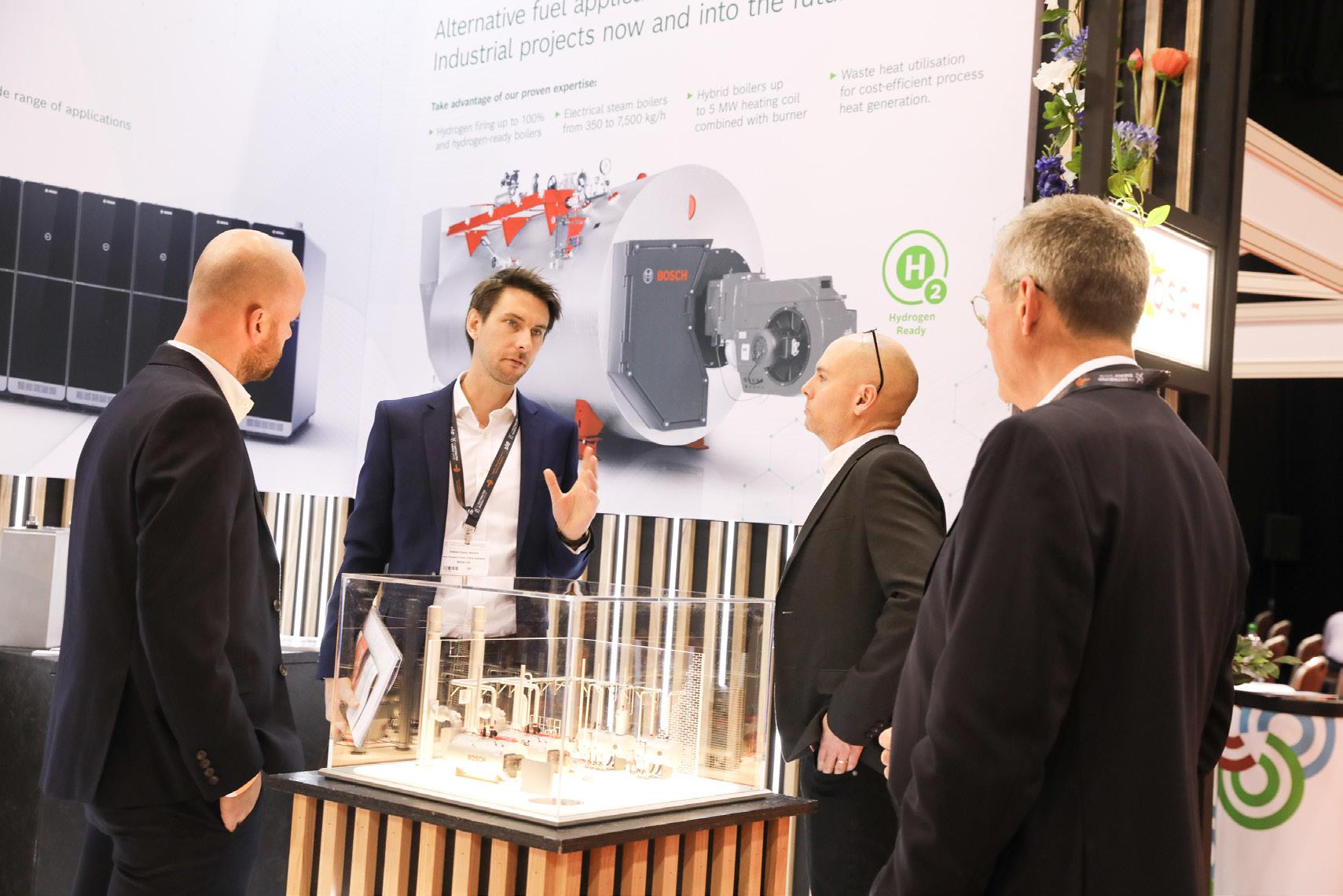





















A sustainable procurement strategy reaches every corner of your supply chain, from sourcing and suppliers to materials and workers. Some examples of sustainable procurement include:
• purchasing electricity from renewable sources
• using energy e icient technologies such as LED lighting








• changing fleet vehicles to ultra-low emission vehicles (ULEV) or electric vehicles (EV)

• using low carbon construction materials













As sustainability continues to grow in significance on the global agenda, it’s imperative to align your procurement strategy with the evolving values of stakeholders, customers, and employees.
Learn how building sustainability into procurement can help you achieve net zero: crowncommercial.gov.uk/procurement-essentials-cnz















MARCH 2023
PUBLISHER: Ralph Scrivens ralph@ energymanagermagazine.co.uk

PRODUCTION: Sarah Daviner sarah@ energymanagermagazine.co.uk
ACCOUNTS: accounts@ energymanagermagazine.co.uk
PRINT: Mixam Print

is published 10 times a year by Energy Manager. www.energymanagermagazine.co.uk
42 Wymington Park, Rushden, Northants, NN10 9JP Tel: 01933 316931
Email: mail@ energymanagermagazine.co.uk
REGISTRATION: Qualifying readers receive Energy Manager free of charge. The annual subscription rate is £80 in the UK, £95 for mainland Europe and £115 for the rest of the world.
Single copies £10.
Some manufacturers and suppliers have made a contribution toward the cost of reproducing some photographs in Energy Manager.
PAPER USED TO PRODUCE THIS MAGAZINE IS SOURCED FROM SUSTAINABLE FORESTS.


Please Note:
No part of this publication may be reproduced by any means without prior permission from the publishers. The publishers do not accept any responsibility for, or necessarily agree with, any views expressed in articles, letters or supplied advertisements.

All contents © Energy Manager Magazine 2023
ISSN 2057-5912 (Print)

ISSN 2057-5920 (Online)


Flexibility is key in making the move to renewable energy sources in the UK; which has always been heavily reliant on fossil fuels. The Distributed Energy Show’s exhibition and conference, taking place on the 14th & 15th March 2023 at the International Centre Telford, is the only event bringing together the technology and expertise energy users need to implement and optimise flexible energy technologies within their organisations.
This event will showcase the very latest advancements in technology, policy and regulation that are enabling commercial and industrial energy users to meet their Net Zero targets, reduce their costs and optimise their energy flexibility.
The free to attend exhibition and conference features sessions including The Current and Future State of the Distributed Energy Sector, with speaker including SSE, Octopus Energy and UK Government Department for Business, Energy & Industrial Strategy. Strengthening Your Energy Resilience in the Face of Growing Supply Concerns, with speakers including Clarke Energy, British Sugar and Centrica. Understanding the Role of Hydrogen and Fuel Cells Technology in the Decentralised Energy Space, with speakers including Rolls Royce and Bosch. Technologies on display at the event will include solar systems, gas turbines, wind turbines, combined heat & power, energy storage systems, small hydro, fuel cells, smart energy systems and platforms, virtual power plant systems, cabling, converters, power electronics.
An expected 2,500 attendees will gather at the event on 14th & 15th
March 2023, including energy users from industrial and manufacturing plants, commercial operations, land owners and public sector building operators. As well as energy suppliers and network operators who will use the show to source technologies and understand the future and advancements in the sector.
Over 90 exhibitors will be at the show for two days of networking, lead generation and education at the Telford International Centre, with organisations confirmed including: Centrica, Clarke Energy, SSE, Rolls Royce, Bosch, Ecotricity, Schneider Electric, Edina, Vattenfall, Conrad Energy and ClearVue.Business.

Matt Pennington, Event Director of Event Partners who are hosting the event says “We are absolutely delighted with the industry-wide support we have for The Distributed Energy Show, which is coming back in 2023 bigger than ever. Major global organisations, SME’s and thought-leaders are helping to shape the event, resulting in the exhibition doubling in size and an increased number of visitors attending the event.”
To stay up to date on all the latest news about The Distributed Energy Show please visit https://distributedenergyshow.com/










 ...RELY ON POWERSTAR
...RELY ON POWERSTAR
SMS plc, a fully integrated energy infrastructure company, and MyUtilityGenius (“MUG”), an energy consultancy, have launched Energy in Schools (“EiS”) to help schools in Britain significantly reduce energy costs and carbon emissions, and to engage pupils in learning about energy efficiency.

A recent survey by the school leaders’ union NAHT found that almost all respondents (99%) were expecting energy costs over the next 12 months to continue rising, with 16% anticipating an increase of 200% or more. More than a third of respondents predicted a budget deficit by the end of 2023, directly impacting their ability to invest in teachers and support for children.
The EiS programme will provide schools with everything required to get started on their energy-saving journey, including a smart meter, easy-to-use smart device sensors, pocket-sized programmable single-board computers (Micro:bit), a TV display, training, support and teaching resources. The integrated solution uses the energy monitoring software to draw data from the smart meters, to monitor energy consumption, and feed it to the TV in order to display the energy dashboard clearly to school users. This enables the school to engage pupils, teachers and visitors in analysing usage and support the behaviour change required to help
manage and reduce consumption. A pilot scheme for EiS across 20 schools, found the following results were achieved:
• Schools implementing EiS could achieve savings of c.7% of on energy costs; 85% of school participants reported more confidence in their knowledge across energy and climate topics with a better understanding of how much energy they used and how to reduce it;
• 89% of schools were motivated to take action to reduce energy consumption, incentivised by the metrics provided by the EiS platform.
EiS – which is designed to help schools align with the Department for Education’s (DfE) ‘Climate Change Strategy’ and the UK government’s wider net zero 2050 goal – uses Microsoft coding and provides tailored lesson plans aligned to key stage two and three, engaging pupils in STEM subjects on climate change and energy consumption. The lesson plans were developed and tested by PGCE qualified experts at University of Lancaster and are designed to support staff, teachers and pupils. In addition, advice, training and an optional audit of school buildings to identify energy saving opportunities can also be provided under the scheme.
Schools can apply for the EiS programme through the website energyinschools.co.uk. Schools may be eligible for funding support to invest in the programme through the DfE, local councils, or their energy supplier.
Tom
Woolley, Smart Product & Strategy
Director at SMS, and spokesperson for Energy in Schools, said: “Unprecedented energy price inflation means schools are under immense pressure to find cost savings. This means finding ways to mitigate the destructive impact of rising bills on school finances, and also reducing the education sector’s contribution to climate change more widely. Improving awareness and education of energy efficiency within schools, whilst providing easier access to technologies that can help schools and students better understand, manage, and reduce their consumption is one the simplest ways of achieving this.
“Energy in Schools is designed to empower schools with technologies and learning resources that can make them role models of sustainable energy use within our local communities, whilst also providing better opportunities for young people to engage practically with the net zero agenda. Ultimately, our goal is to help safeguard the future prospects of our school system, our children, and our planet.”
David Page, Deputy Head & Computing subject leader, Jennett’s Park Primary School: “The Energy in Schools project has been fabulous. It has provided the children with a rich and meaningful context that has been truly empowering to them. They have taken responsibility to monitor the energy use across our school and make meaningful differences to energy consumption. The project has also strengthened their views of themselves as global citizens.” Find out more at energyinschools.co.uk
‘Energy in Schools’ provides energy management and educational tools that could help schools save thousands of pounds per year on energy costs and reduce carbon emissions The programme will provide schools with smart meters, technology devices and learning resources to encourage lower consumption and energy efficiency education amongst students
to power a cleaner world.
Connected Energy specialise in battery energy storage systems that give businesses flexibility over their power. Our systems let businesses store electricity – either from their own building supply or from renewables – and use it when they need it most.
Find out how we can help transform your energy use: www.connected-energy.co.uk


Agrowing number of companies and organizations are setting ambitious goals to become net-zero carbon emitters, with many targeting 2023 and beyond for achieving these goals. As part of their efforts to reduce their carbon footprints, many of these companies are turning to the carbon credit market as a way to offset their remaining emissions. Carbon offsets are essentially a way for companies and organizations to pay for emissions reductions elsewhere in order to compensate for their own emissions. This allows them to reduce their net carbon footprint and achieve their net-zero carbon goals.
One of the key ways that carbon offsets are helping companies to reduce their carbon footprints is by funding the development and deployment of renewable energy sources. These projects can include wind farms, solar panels, and other forms of clean energy that help to displace fossil fuels and reduce overall greenhouse gas emissions. By purchasing carbon credits from these projects, companies are able to support the development of renewable energy and offset their
own emissions at the same time.
Another way that carbon offsets are helping to reduce carbon footprints is through the support of carbon capture and storage (CCS) technologies. CCS involves capturing carbon dioxide (CO2) emissions from power plants and industrial facilities, and then storing them underground in order to prevent them from entering the atmosphere. By purchasing carbon credits from CCS projects, companies are able to offset their own emissions and support the development of this important technology.
While carbon offsets can be a useful tool for companies looking to reduce their carbon footprints, it is important to ensure that they are properly regulated. This is because not all carbon offsets are created equal, and some may be less effective at providing an environmental benefit than others. For example, some carbon offset projects may not result in real, permanent emissions reductions, or may not be verified by an independent third party.
To address this issue, many companies are turning to voluntary carbon offset standards, such as the Verified Carbon Standard (VCS) and the Gold Standard,
which provide rigorous, independent verification of emissions reductions. These standards help to ensure that carbon offsets are high quality and provide real, permanent emissions reductions.
Despite the challenges, the carbon credit market is poised to become an increasingly important part of the conversation surrounding climate change in 2023 and beyond. As more and more companies set ambitious net-zero carbon goals, the demand for carbon offsets is likely to increase. This, in turn, will drive innovation and investment in the carbon offset space, leading to the development of new and improved offset projects.
Overall, carbon offsets are playing a crucial role in helping companies and organizations reduce their carbon footprints and achieve their net-zero carbon goals. While there are still challenges to be addressed, the carbon credit market is likely to become an increasingly important part of the broader conversation surrounding climate change in the coming years.
https://bluespherecarbon.com/

Bath and North East Somerset has become the first council in England to successfully adopt an energy-based net zero housing policy as part of its commitment to tackling the climate emergency.
The new housing development policy will ensure the energy use of any proposed development is measured and meets a specified target – setting a limit on the total energy use and demand for space heating. It will also require sufficient on-site renewable energy generation to match the total energy consumption of the buildings – ensuring the development is 100% self-sufficient.
New policies will also address building emissions such as a policy to limit carbon emissions resulting from the materials used in the construction of large-scale developments. These ‘upfront’ embodied carbon emissions will be limited to 900kgCO2e/m2
The council will also impose net zero operational carbon standards for new major non-residential development.
The Local Plan sets out the basis for decision making on development and
the use of land that requires planning permission across B&NES. The adopted LPPU includes some changes, known as main modifications, that were suggested by an independent planning inspector to ensure the Local Plan Partial Update (LPPU) would be sound and legally compliant. They were consulted on last year.
The LPPU includes specific policies that will secure net zero development, help facilitate the delivery of renewable energy installations of an appropriate scale in the most suitable locations and further encourage the shift towards more sustainable forms of transport.
It will also help to replenish housing supply, enabling the council to meet its housing requirement in a planned way and have greater control over speculative planning applications. In addition, the LPPU will help the council to better manage off-campus, purposebuilt student accommodation schemes where they meet a demonstrable need.
The new Biodiversity Net Gain policy requires major developments to demonstrate a Biodiversity Net Gain of
a minimum of 10% which is secured in perpetuity, for at least 30 years. Minor developments will only be permitted where no net loss and appropriate net gain of biodiversity is secured.
The council liaised with Cornwall Council and used their evidence base to support the new net zero construction policy.
The recent adoption of the Sustainable Construction Checklist SPD provides the reporting framework to demonstrate compliance with the new sustainable construction policies and the council’s partnership with the University of Bath will help to evaluate implementation and industry response.
The policy is the first new housing policy to be net-zero aligned based on 2030 trajectories of industry-leading organisations such as the London Energy Transformation Initiative (LETI), the Royal Institute of British Architects (RIBA) and the Chartered Institute of Building Services Engineers (CIBSE).
https://beta.bathnes.gov.uk/ policy-and-documents-library/ future-policy-local-plan
The Building Controls Industry Association (BCIA) has released two new Technical Guides to add to its portfolio of online Guides available to download.

The first Guide covers the various Building Assessment Schemes, including BREEAM, LEED, NABERS, RESET, WELL Being Standard, and WiredScore. Building Assessment Schemes set performance standards for the built environment, including new builds and refurbishment, by assessing a project’s environmental impact through the design, specification, construction and operation phases of a building.

The second Guide provides an overview of the UK and European Regulations for non-domestic buildings. Nondomestic buildings account for 11% of the total annual energy consumption and carbon emissions throughout the UK and Europe. Historically driven by the European Union and adopted into UK law, the Energy Performance of Buildings directive (EPBD) and the Energy Efficiency Directive (EED), have been the instruments to regulate energy consumption and set targets to reach net zero carbon emissions. Since the United Kingdom left the European Union, the department for Business, Environment, and Industrial strategy (BEIS) has become responsible for setting the environmental, net zero and sustainable goals for the future.
The BCIA’s Technical Guides are designed to help members and those in the building controls and BEMS industry work more effectively. All Technical Guides can be downloaded from: https://bcia.co.uk/resources/



Johnson Controls (NYSE: JCI) has been recognised by LexisNexis as one of the world’s most innovative companies in its latest report, “Innovation Momentum 2023: The Global Top 100.” Top 100 recognises companies advancing innovative solutions to today’s challenges and laying the intellectual property foundations for further breakthroughs.
The Innovation Momentum methodology captures two years of dynamic innovation. It recognises innovative companies that are outperforming their peers in technology relevance, the potential to lead to further inventions and market coverage, and the size of the global market a patent family protects. The index behind the report combines these metrics to arrive at the competitive impact or the average quality of an entire patent portfolio.
Karl Reichenberger, chief intellectual property counsel, Johnson Controls said: “It is an honour to be recognised as a Top 100 company for 2023, and I applaud our global team of innovators along with our legal team who helps protect their ground-breaking inventions and ideas.” https://www.johnsoncontrols.com/en_gb

At the World Economic Forum in January, the U.N. Secretary General called on business leaders to make ‘’credible and accountable’’ net zero pledges – highlighting the need for organisations to match ambition with action when it comes to implementing their climate goals. Nearly two-thirds of organisations have taken the first step by making public commitments to reduce carbon emissions. However, achieving decarbonisation goals requires sustained effort, investment, and strong leadership. Although many organisations have a decarbonisation commitment, only 12% believe they are on track to meet or exceed their goals according to a recent report from ENGIE Impact. Many have achieved most of the “quick wins” and now face harder-to-address challenges. For those organisations that take on these challenges and do overcome decarbonisation barriers, it is compelling to note – according to ESG Book and Reuters – stocks of companies with ESG-positive portfolios can outperform competitors by more than 1.5%.
Decarbonisation should be a priority for organisations looking to achieve longterm competitive advantage. Even with the challenges of balancing short-term return on investment and rising energy and raw material costs, maintaining decarbonisation efforts – even through periods of volatility – will be a boon to short- and long-term corporate goals. Decision-makers need to look beyond the short-term volatility in energy and financial markets by focusing on how continued investment in decarbonisation will drive long-term competitive advantage.
There can be significant challenges to establishing the best organisational structure to achieve decarbonisation goals. Many organisations start with a centralised model, providing clarity to organisational priorities and oversight to capability investment. As they mature, many move toward a more delegated model with resources and expertise more closely aligned to business units,
functional areas or geographies –nominating champions to coordinate local efforts. Each company should weigh the pros and cons of each governance model to choose an approach that maximises the return on their decarbonisation investment and minimises disruption to their current operations. Failure to address this issue early in the sustainability process can result in tension between strategy and implementation.
Strong leadership and commitment are crucial to achieving sustainability goals, but lack of incentive and ownership at the executive level is a barrier to progress. Executives need to be held accountable for decarbonisation commitments, treating them as seriously as financial targets. Bonuses for decarbonisation goals need to be significant to change behaviour and not just given to executives, but to all employees involved in reaching established goals. This way, everyone is held accountable and incentivised to prioritise carbon-reduction efforts. This also reinforces the need to have a reliable carbon data management infrastructure to track and measure progress toward these goals.
Any disconnect between the expectations of executive management and those in operational roles can lead to implementation challenges. Often, executive decision-makers tend to be more optimistic the current state of their decarbonisation efforts, while operational leaders tend to be more aware of the reality. This misalignment creates risks, as executives may underestimate the effort and investment required, and operational leaders may struggle to make the case for faster progress. To overcome this, organisations should align under a common decarbonisation purpose and process, which can help clarify priorities, milestones and investment requirements.
An organisation’s decarbonisation can support – and even boost – existing business targets if there is proper
alignment of resources, goals, and capabilities. Three enablers can help accelerate this process: innovative finance models, carbon pricing, and carbon data maturity. Adopting innovative finance models, such as green bonds or financeas-a-service, helps unlock capital for investment and reduce investment risk. Carbon budgeting can be used to assign a carbon value to activities and forecasts outcomes based on emissions risk and reduction potential. Data maturity works best when there is a single source of truth, utilising the right digital tools to enable transparency and action.
Organisations need to address not only their own carbon emissions but also those produced by their supply chain, known as Scope 3 emissions. Working with a supply chain can be a major barrier, so collaboration that includes setting clear decarbonisation expectations with suppliers is vital. Some organisations have even incorporated decarbonisation commitments into procurement contracts and offer financial incentives to suppliers who meet specified targets. With clearly defined decarbonisation targets in place, you can identify areas of mutual interest and collaborate on initiatives aimed at reducing Scope 3 emissions.
Many organisations have committed to reducing carbon emissions, but few believe they are on track – likely because they are beginning to face more significant decarbonisation challenges in the context of the current economic downturn. With the right partnerships, strategy, and carbon data management in place, any organisation can take the proper actions to overcome those implementation barriers and work to reduce their carbon footprint. This should be top of mind for business leaders as we move forward in the new year, as any delay on implementing the right decarbonisation levers will make the targets even harder to reach, potentially even rolling back the clock on progress made thus far.
https://www.engieimpact.com/

In accommodation where the room occupant is not directly responsible for paying the heating bills, it is difficult to control how much energy they are using. Our purpose is to enable Energy and Accommodation Managers to take control of energy use, while ensuring rooms remain comfortable.


This rate of growth surpasses that of the fintech sector’s two-fold increase to $10bn a decade ago. And this surge in investment happened before energy prices skyrocketed in the UK and Europe.

Climate change is creating extreme weather events that are wreaking havoc on our power grids. In 2021, skyrocketing temperatures taxed Texas’s grid to the point where the entire state was just four minutes away from a total blackout that could have meant no power for weeks, or even months. California encountered a similar situation last year, when overuse of ‘dumb’ HVAC systems during recordbreaking heat waves resulted in the state using double the energy of the UK despite only having half the population.
However, as the world transitions to renewable energy sources to slow extreme meteorological manifestations, the challenge of bringing power to the areas where they are needed, when they are needed, is becoming increasingly apparent.
The issue is compounded by the fact that renewables are often generated in locations distant from areas of high demand – for example, hydroelectric power in Scotland and demand in London. Even in cases where energy generation and demand are in proximity, they are often not in sync. Solar energy, for example, is produced during the day but peak demand occurs at night.
These factors highlight the importance of grid flexibility in our transition to renewable energy. In response, we see increased investment into a growing number of software-driven startups introducing new solutions that strengthen grid flexibility to maximise energy utilisation. In fact, investments in energy flexibility software startups quadrupled in 2021, reaching an impressive $10bn.
New smart grid solutions are enabling Distribution System Operators (DSOs) to connect all their data sources, which until now have been siloed. They allow for granular energy usage and production monitoring minute by minute, and even ‘behind the metre’ (in residential locations) to enable the grid to respond more quickly.
One prominent example is Plexigrid which since being founded in 2020 has collaborated with EDP, a major Portuguese utility company, to create a groundbreaking grid-centric flexibility management system that allows DSOs to distribute more energy with their existing network capacity.
The system applies intelligence to traditional grid systems, connecting data from grid planners, operations and retailers to flexibility pools across the grid. Implemented broadly, the solution can significantly strengthen grid flexibility and save electricity grid operators worldwide up to $300bn each year in capacity upgrades.
Swiss startup DEPsys, is another major player in the smart grid space. The company’s core Grideye platform combines hardware and software components to produce and process high-precision, real-time data. The platform can monitor, operate, analyse, control and automate any low and medium-voltage power distribution grid, and larger energy players have recognised the necessity for deeper insights, with Octopus Energy snapping them at the end of 2022.
Dublin-based startup GridBeyond has built a platform that works with grid operators to balance the electricity network. The platform connects to energy-intensive assets and monitors them in real time. When the grid becomes imbalanced, the

system automatically adjusts energy consumption for a short period.
The platform ensures that there is no interruption or impact to operations and enables users to earn revenues for helping to balance the grid. It helps reduce energy bills by shifting usage away from times of high charges or penalties and provides equipment optimization capabilities that identify areas where energy is not being used efficiently.
Finally, there is Cuculus, who is helping expand smart meter access for all energy providers. Utility companies typically have access to one type of meter on their system, but Cuculus homogenises the smart meter software and accelerates data collection from customers as more meters can be rolled out. Covering all types of utilities and collecting data such as power consumption, water flows, and temperatures, they process billions of datapoints per day and give providers unprecedented views into the grid network’s health.
A Virtual Power Plant (VPP) is a system of interconnected distributed energy resources (DERs) such as solar, battery storage and other renewable sources. These resources connect to a central control system managed as a single entity to provide grid services, optimise system performance, and reduce energy costs. This allows for generating electricity reliably from multiple sources, providing greater energy security for the grid and end-users and greater control over the energy mix.
Virtual Power Plants are helping distributed renewable energy resource producers, including small-scale electric generation and storage units such as rooftop solar photovoltaic units and biomass generators, to connect to the larger power grid.
Piclo is the UK’s leading independent marketplace for flexibility services. The company’s cloud-based platform enables electricity networks to buy flexibility
services from flexibility providers at scale to support network resilience, defer grid reinforcement and advance network reliability. The Piclo Flex platform is paving the way for new low-carbon technologies, such as electric vehicles, energy storage and flexible demand to balance the grid at a lower cost.
Some VPPs such as Statkraft, are already contributing multiple traditional power plants’ worth of capacity. Statkraft operates the largest VPP in Europe and has more than 10 GW installed capacity from over 1,000 renewable energies power generators. This is equivalent to 10 thermal power plants that could power a major city.
By connecting small producers virtually, Statkraft allows the connected DERs to work together as a single and virtual power plant by means of a centralised control system that can be used to reliably supply energy to the broader grid. The artificially created entity can be traded in the market but can also connect directly to smalland large-scale consumers such as storage and industrial consumers.
The next generation of VPPs will integrate electric vehicles and home solar systems as backup power sources for the electricity grid. They will also be made up of fleets of smart thermostats and other appliances that can adjust their power use to reduce stress on the grid. Some big names in smart homes, solar power, and electric vehicles recently launched a coalition called Virtual Power Plant Partnership (VP3) to develop standards and policies for virtual power plants. Members include Google Nest, General Motors, Ford, SunPower and Sunrun.
Demand response solutions provide an opportunity for consumers to actively participate in the operation of the electric grid by reducing or shifting their electricity usage during peak periods. By responding to time-based rates and other financial incentives, consumers can reduce their electricity usage during peak demand periods, leading to lower costs and rates.
With demand response solutions, energy-intensive HVAC systems (for example) become more intelligent. They can manage energy consumption based on energy costs, user schedules and other environmental factors, reducing peak loads on the grid during extreme weather conditions.


Amsterdam-based Sympower –which recently secured €22 million for its proprietary software platform, is now working to enhance grid flexibility in many European countries. The company partners with leading industry players and industrial consumers, leveraging its proprietary software platform to adjust the power of systems, machines, and processes in response to fluctuating grid conditions.
For example – the company’s solution can adjust the temperature of industrial freezers to match grid electricity levels. Such freezers can be programmed to consume more electricity when the sun is shining and there is plenty of power on the grid. The temperature can then be reduced in the evening when temperatures cool and there’s less electricity demand.
Grid operators pay Sympower for this functionality. The company then divides the profits with its customers (the owners
of the flexible assets), whose electricity costs can be lowered by up to 15%.

While the transition to renewable energy resources promises a cleaner and more sustainable future, there is a pressing need to make our grids far more intelligent, efficient, and adaptable. The potential savings will be enormous. Smart flexible grids were initially anticipated to save up to £40bn in the UK alone over the next three decades. We believe these savings are likely to be several times this number given the improvements seen over the last few years.
It’s still early days though. Smart grid projects are still small-scale and not yet viable for widespread deployment. Most energy distributors also have yet to invest significantly in the sector or use distributed energy management tools.
However, we’re starting to already see more DSOs participating in well-established smart grid pilot projects and regulatory sandboxes. Many are also preparing 10-year network investment plans that will spur investment and innovation in the coming years in addition to the VC investments flowing into the space.
The return on investment for software powered flexibility solutions is already clear and compelling. This is particularly true with the sharp jump in energy costs during 2022. So much so that in our view we expect funding to grow 3x in the next couple of years to surpass $30bn by 2025. This puts flexibility software’s funding growth on a par with fin-tech a few years ago, and positions it as perhaps the hottest ‘hidden’ software sector in the market today. https://www.daimagister.com/
Public sector organisations often find themselves with the unenviable task of trying to reduce costs without impacting on service delivery. This becomes even more acute in periods of recession or slow growth.
One essential area to look at is energy management. Regardless of sector, every business has an energy profile, and more often than not there is room for improvement. Smarter energy management will reduce costs without impacting on service, and also help organisation’s reach their Net Zero and sustainability goals.
This may feel like a daunting task, especially in buildings with high usage or multi-site organisations. However, an energy profile is critical in building the baseline and identifying opportunities for energy reduction – and the cheapest kWh is the one you don’t use.
Organisations can create their energy profiles through granular data collection and modelling, and then manage it through a proprietary data platform or Building Management System (BMS) control system. The first aspect of the strategy will be to look at baseload management. Initiatives such as night walk rounds are useful to help define the baseload and see where reductions can be made.
In a post-pandemic world facility managers need to consider sensors and greater automation to better manage erratic occupancy patterns in their buildings. This will allow HVAC systems to be more demand driven, enabling the smarter use of energy whilst also extending the life of building services assets.
A university library may be open 24 hours, but only sparsely
occupied during the night. Sensors will reveal exact occupancy levels so that heating, cooling and lighting systems can respond accordingly.
Some energy reduction efforts will also need support from building users. Sticking with the library example, an awareness campaign for students would be an integral part of the energy management strategy encouraging things like switching off computers and monitors.
A recent study by the National Union of Students found that 87 per cent of all students agreed that their university should take sustainability more seriously. So, it’s likely most will be happy to help with energy reduction – they just need some guidance.
All of these efforts can add up across the entirety of an estate to make a noticeable impact. Yet there is more than can be done to help organisations further reduce costs.
Though energy prices have been particularly turbulent recently, the fact is that the energy market is a volatile one at the best of times. There are hundreds of factors that can impact prices on any given day.
As such, energy should be treated as a long-term price risk management project rather than a procurement activity. This can be a departure from the norm for many businesses and may not always be easy for some in the public sector, but as a strategic decision it should be an objective for every business.

There are countless examples of organisations using protracted procurement processes to appoint energy brokers whilst not appreciating that the cost of the service is relatively small in comparison with their actual energy spend, and in the intervening period the price of energy has moved so much that the small savings made
on the broker contract are totally wiped out. Procurement also tends to focus on the cheapest deal at the time, as opposed to taking a longer-term view that is required from a risk management standpoint. What appears to be a more attractive fixed price deal at first can have a sting in the tail when it’s time to renew the contract and prices have surged.
I have met many organisations that take different approaches to energy management. One company bought out energy when the markets were historically low in spring 2016 and then again at the start of the pandemic. As a result they have been shielded from the turbulent prices since early 2016 and will be until the end of this year. Conversely, another company that took the “traditional” route with energy contracts paid £10m for electricity in 2021, £22m in 2022 and likely more this year for its campus HQ alone.
For those businesses that do not have the in-house expertise for energy price risk management, I recommend finding a partner or energy broker that offers the best risk management strategies and complete transparency in their fee structure to ensure there are no undisclosed payments. The expertise is well worth the investment and will be made back many times over with the new energy strategy.
Working with the right partners could help your business save huge amounts on its energy bills. We work with expert partners, such as Verco and LG Energy, to support our clients on their energy management and Net Zero journeys.
Changing the approach to energy management may not happen overnight, but there’s no better time to start the conversation – the numerous benefits are simply too good to ignore.
https://www.emcoruk.com/

Kam Singh, director of carbon solutions at EMCOR UK, offers advice to public sector energy managers on how they can understand their business energy profiles, as well as advice to protect themselves from price rises in the volatile energy market.
Steam – this extraordinary, energy dense, fluid which is irreplaceable in all kinds of industries to heat, power and sterilize – leaving nothing but water behind. And with advancing steam generation solutions, steam is part of our sustainable future. This is Natural Technology.


You see steam. We see...
Energy consumption is a growing concern for businesses worldwide driven by sustainability schemes and cost reduction initiatives. In the past 12 months, the latter has become a greater priority as soaring energy costs create a burden on the operations of many organisations in the UK. The June 2022 Business Energy Tracker survey from npower found that 77% of UK companies considered energy costs to be the biggest concern for the coming year.1 That same report highlighted that 60% of businesses felt that not enough was being done to support them amid escalating costs.
The UK Government implemented a cap on wholesale business energy bills starting October 1, 2022, that will initially run for six months to cover businesses during the winter period.2 Although the UK Government has stated it will review the business energy price cap closer ahead of its scheduled end, many businesses remain concerned. It’s essential that businesses take steps to reduce their energy usage – both for the short-term savings and to meet long-term goals.
Cost is often a challenge that many businesses are face when working to reduce energy usage. Many energy managers start with larger scale or longer-term efficiency projects, such
1 npower Business Solutions, Business Energy Tracker 2022, June 2022 [Accessed September 23, 2022]
2 AP News, UK businesses laud energy relief, but costs still a struggle, Kelvin Chan, September 22, 2022 [Accessed September 23, 2022]

as modernising heating, ventilation and air-conditioning (HVAC) systems or improving building insulation. These efforts can create substantial reductions in energy usage but often come with sizeable upfront investments that may not be viable with tighter budgets and may take a longer time to demonstrate savings.
There are other actions that can offer meaningful reductions in energy usage with a shorter payback period. One of the most overlooked during efficiency improvement plans is small power usage, which relates to the volume of power consumed by power outlets and plugged-in devices.
There can be hundreds or thousands of electrical devices in a typical commercial building, ranging from desktop computers and printers to vending machines and water coolers. Although the power requirements of these individual devices pale in comparison to the consumption of HVAC systems, they collectively can account for a significant percentage of a building’s energy use. Data indicates that small power can account for up to 25% of energy in a minimally efficient building,3 or as much as 50% in buildings that have already installed high efficiency lighting and HVAC systems.4
The difficulty with managing small power traditionally is if the capabilities to monitor and control it even exists in a building. Historically, electrical sockets have not been integrated into a site’s building management system (BMS). New technologies now make it possible to connect electrical sockets to the BMS to
3 US General Data Administration, Plug Load FAQ, Poll, S. and C. Teubert, 2012 [Accessed September 23, 2022]
4 New Buildings Institute, Plug Load Best Practice Guide – Managing Your Office Equipment Plug Load, July 17, 2012 [Accessed September 23, 2022]
enable constant insight and control of small power loads. This can help identify any sockets across a site that have been left powered on unnecessarily by building occupants, as well as any devices in sleep mode that would otherwise silently sap electricity without staff noticing. Energy managers need this level of visibility in their buildings to accurately assess opportunities to lower site energy consumption.
This technology serves to help energy managers recognise the collective impact of small power. With a suitable solution in place, energy managers can begin cutting the power consumption of electrical outlets by establishing a plan to address it as much as possible, whether by encouraging occupant behavioural change or incorporating outlet inspection into routine site rounds and audits.
The energy cost challenge faced by businesses is two-fold: the cost of energy is creating financial hardships for many businesses which is in turn impeding their ability to invest in larger efficiency improvements. It’s therefore critical that energy managers do what they can to drive down building energy use in as quick and costeffective way possible. The cumulative benefit of addressing small power can deliver on this – and demonstrate effective results in a timely manner.
To apply for a free small power consultation for your commercial building, simply fill out the form – https://hwll.co/ discoverconnectedpower – and a MK Honeywell representative will be in contact to assist you further.

Energy managers are seeking new ways of reducing energy usage across their buildings amid escalating energy costs. While many are taking steps to reduce energy use, one of the largest sources of wasted electricity is often still hiding in plain sight, writes Steve Kenny, vice president and general manager, MK Electric.


The cheapest and greenest unit of energy is the one you don’t use, so a solution that cuts kWh usage is especially helpful for public sector organisations. In the current climate – where options to negotiate tariffs and switch suppliers have dwindled as suppliers have been taken over or gone altogether – one of the best options for energy strategies is Voltage Optimisation (VO), a technology that can offer guaranteed savings.
VO helps reduce on-site electricity usage by stabilising incoming voltage and reducing voltage levels as supplied by the Grid. To ensure that it meets its statutory obligations – within the allowable range of 230V +10% / -6%, or between 216 - 253V – the National Grid’s typical supply is higher than 230V – a significantly higher voltage than the 220V operational requirement for most UK electrical equipment. Operating at a higher voltage than necessary can cause damage to equipment, shortening its lifespan and increasing maintenance costs, while also hitting budgets with wasted energy costs, and creating unnecessary carbon emissions. VO works by optimising the incoming supply from the Grid to match the voltage required by on-site equipment. Traditional VO transforms the entire output, meaning that voltage is reduced but current increases, whereas Powerstar’s patented VO includes a third winding, creating a negative voltage whereby only subtractive power is transformed, reducing both voltage and current, meaning much lower percentage losses.
While VO technology offers the greatest returns for sites consuming high levels of electricity, there are flexible options available - such as Powerstar’s

LITE version which subtracts a set voltage from the incoming supply, or the MAX option which dynamically adjusts voltage subtraction regardless of incoming supply variations. This means there are opportunities for savings across all site types and sizes, and Powerstar work with NHS clients from major hospital sites to small, locally focused health centres.
Sheffield Teaching Hospitals is one of the largest NHS Foundation Trusts in the UK, employing more than 15,000 staff across five hospitals, including The Royal Hallamshire Hospital where nearly 6,000 staff work


The public sector is under extreme pressure, with health services hit hard. Given the level of energy costs, Solon Mardapittas, CEO at Powerstar, looks at Voltage Optimisation – a technology offering transparent and easily quantifiable cost savings and emission reductions.The Royal Hallamshire Hospital
return on investment. When tasked with advising on energy saving solutions for Royal Hallamshire Hospital, Powerstar undertook a comprehensive review of power usage on-site and recommended VO as the most appropriate technology for Trust investment. Installation of Powerstar’s MAX voltage optimisation solution has achieved a 5.1% saving on energy consumption, reducing the hospital’s power demand from the Grid by 11.57%, largely due to the improved power factor from an average of 0.851 to 0.925. Alongside costs savings and emission reduction, critical and costly specialist equipment within the hospital is protected from excessive voltage – helping to extend its lifespan and reducing maintenance costs.
When Widnes Health Care Resource Centre approached Powerstar, looking for recommendations to improve efficiency, VO was again deemed to be the most suitable technology. The Centre itself is relatively new, and is home to Oaks Place Surgery, a small GP practice that has served Widnes for over 30 years. Powerstar’s site survey showed that VO would cut spending on energy, reduce carbon emissions, while boosting energy resilience to the site by providing more
stable power supply. Installation of a 226kVA system has eliminated 46.8 tonnes of carbon dioxide each year, reduced energy consumption by 15.7%, providing a net return on investment in just over two years.


For healthcare facilities where dynamic VO is recommended as the most appropriate option, clients have the additional benefit of remote monitoring, meaning site consumption, harmonics, power factor and voltage can be accessed, while alarms are recorded and stored to give a clear picture of asset performance and proof of savings – typically between six and ten percent. While the benefits of VO for the NHS are clear, there is a compelling case for wider uptake across the UK. If voltage optimisation were to be installed across the country, it could save 11,760 tonnes of CO2 a day – 4,292,400 tonnes per year, equivalent to taking nearly a million
cars off the road.1 In an energy crisis, and given the UK’s commitment to Net Zero, this represents significant strides towards a more sustainable future.
To find out more about Powerstar’s solutions for the healthcare sector, download our NHS white paper, Solving the Healthcare Sector’s Energy Trilemma: https://offers.powerstar. com/nhs-white-paper or contact us: W: www.powerstar.com T: 0333 230 1327 E: info@powerstar.com
1 https://bettwerworldsolutions.s3-eu-west-1. amazonaws.com/VO-info-document_UKGlobal-saving-stats-AESSEAL.pdf



UKpublic sector organisations are under pressure to do more for less. That was the message recently from management consultants hoping tighter government spending this year will spark more work, as departments and local authorities seek help with cost-cutting and restructuring.
Following record levels of government borrowing in recent months, ‘easing the squeeze’ will be front of mind for businesses and the public sector ahead of the Chancellor’s Spring Budget next month.
When it comes to energy, the country faces an epidemic of waste, particularly within public sector. Every year a significant proportion of the energy purchased by schools, hospitals, council buildings, prisons and other large public sector premises is either lost or used inefficiently. This isn’t limited to the public sector; studies suggest that 30% of energy consumed in commercial properties is wasted through a combination of out-ofdate and inefficient equipment, poor insulation, and behavioural factors.
According to the Let’s Go Zero schools campaign, 60% of energy used by schools is wasted out of school hours. UK education buildings alone waste £860 million in energy annually. Energy wastage is impacting already squeezed budgets, potentially putting patient care and safety in jeopardy.
This current scale of energy waste also coincides with a time of unprecedented industrial action by nurses, paramedics, teachers, fire brigades and public sector workers. It stands to reason that less money lost to energy waste could support ongoing negotiations.
It’s also costing British taxpayers billions every year, yet much of it
is unnecessary and could be easily eliminated. But it’s not just about price. Simple efficiency measures can also significantly reduce the carbon emissions of buildings, supporting the route to Net Zero.
So, what can be done about it?
Knowledge is power and prevention is better than cure. Any effective, practical action plan to reduce energy spend must begin by identifying energy wastage through a granular measurement system.
Intelligent metering solutions for businesses, such as eEnergy’s MY ZeERO, go beyond “smart meters” found in homes and businesses, providing data on the exact usage and cost – down to the penny – of energy consumption by every asset within each area of a school, hospital or other public sector premises.

This data ensures users aren’t left attempting generic actions to reduce costs – or worse, paralysed by a lack of actionable insights.
Using data and insights provided by solutions like MY ZeERO, organisations can also implement specific behavioural changes to instantly reduce waste.
For example, if data shows a disproportionate amount of electricity use out of hours, this could suggest that lights are being left on at the end of the day, or that equipment is running when not in use. Steps such as installing timers in combination with energy-efficient LED lighting can save thousands of pounds a year, cutting down otherwise ‘invisible’ waste.
Granular energy measurement will also identify where machinery
or appliances are wasting energy by being left switched on or on standby, or through inefficiency or misuse. For example, using data from MY ZeERO, one London school realised a service elevator was being used by pupils. Shutting off access to everyone but the caretaker saved £2,000 a year alone.
In addition to energysaving measures, public sector organisations can invest in technology to further reduce bills. Lighting typically represents around 40% of schools’ energy bills. Simply replacing standard lighting with energy-saving LED lighting can typically reduce lighting energy costs by at least 50-55%, and often by up to 75%.

Continued measurement is vital to keep further wastage at bay and to encourage positive behaviour change among staff and other users, whose engagement and cooperation is critical to efficiency efforts.
These simple steps could provide great gains for the UK’s public sector; not least in relation to government spending and economic prosperity, but to ensure the quality of public service provision and wider national Net Zero ambitions.
We believe reaching Net Zero should be both possible and profitable for all organisations, and with MY ZeERO’s granular measurement, creating an energy action plan has never been easier. If you’re ready to start measuring your energy use and identifying savings, we’re ready to help you take the next step.
To learn more about how eEnergy can help you become more energy efficient and unlock new revenue, visit www.eenergy.com email tracey.fletcher@eenergy.com or call 02476 998 257
For Cambridge-based Artisan Electrics, a company that prides itself on observing the highest professional standards, it looked like a straightforward project. The company had been contacted by Nimbus Hosting, a specialist in eco-friendly web hosting, with a request to install a battery system to capture surplus energy that was being produced by its solar power installation. Nimbus Hosting had supplied Artisan with data covering the twelve months since the solar panels had been installed and, on the face of it, this showed that the panels were producing a healthy surplus of power every day.
Based on this data, Artisan engineers sized and designed a battery system, and were ready to proceed with installation. Before starting work, however, they carried out a preliminary site visit to carry out the final checks that would ensure the work would proceed smoothly. As would be expected, this included checking on the arrangement of the solar power installation. This produced something of a shock – but not of the electrical kind!
Artisan discovered that the CTs monitoring the power used by Nimbus Hosting had been installed in the wrong place. They had been fitted in a sub distribution board where they only measured a fraction of the total power being used by the company. This instantly suggested that the surplus of power being produced by the solar panels might not be quite as healthy as the data supplied – in good faith – by Nimbus Hosting.
To accurately determine the real situation, Artisan temporarily installed a Chauvin Arnoux PEL103 power and energy logger in Nimbus Hosting’s main distribution board. This was done rather than simply re-positioning the incorrectly installed CTs because installation of the PEL was fast and easy, but because it could be depended on to provide reliable results, and because it would provide more comprehensive and more detailed data than the original set up.

Within just a few hours, the results provided by the PEL were a revelation. Far from producing a large surplus of power, Nimbus Hosting’s solar panels were, almost all of the time, producing far less power than the company was using, making it a net importer of energy from the grid. It seemed that


there would be no surplus power available to charge the battery during daylight hours and the company’s idea of using the battery to power its operations during the hours of darkness would therefore be unachievable.

in place for a month uncovered a rather more complex and more interesting picture. The first and most obvious finding, discovered in the first week of data logging, was that the building heating had been left on over the weekend, wasting a lot of costly energy. This issue was quickly addressed.
More interesting was the discovery that on Saturdays and Sundays, there was indeed a modest surplus of power from the solar panels which could potentially be captured by a battery installation. Since the data had been captured during October, it was also possible that even better results might

be obtained during the summer months when sunlight levels are higher and the hours of sunlight are longer. However, this could only be confirmed by extended monitoring through the summer.
The data from the PEL also showed that, while the phase voltages were closely matched, the phase currents were not, with one phase being almost twice as heavily loaded as the other two. This indicated that if a battery system were to be installed without other changes being made, a three-phase system would not be appropriate. Instead, separate single-phase battery systems would need to be used for each of the three phases so that the difference in loading could be taken into account.

After analysing the plethora of data captured by the PEL in detail, using the supporting software supplied by Chauvin Arnoux, the engineers at Artisan were able to make some soundly based recommendations to Nimbus Hosting. The first was that with the present arrangements, installing a battery system would be likely to bring only small benefits, even in the summer months. However, as Nimbus Hosting has unused roof space, fitting additional solar panels would transform this situation and, with the aid of a suitably configured battery system, help the company to achieve its ultimate objective of completely eliminating the need to draw power from the grid.
Based on data from the PEL, Artisan also advised that it would be advantageous for Nimbus Hosting to consider reconfiguring its loads to achieve a better balance between the phases. This might allow the use of a three-phase battery system, which would be simpler and less costly than using separate single-phase systems.

In this case study, reliable data provided by a Chauvin Arnoux PEL103 has prevented a costly mistake based on incorrect information. Had the battery system originally planned for Nimbus Hosting been installed, it would have been significantly oversized because a large energy surplus had been predicted, and it would have been of little practical value.
The moral of the tale is that it always pays to monitor power systems with instruments of known accuracy before carrying out modifications – monitoring is an inexpensive exercise and, with a purpose-designed instrument like a PEL103, it can be carried out without disruption or inconvenience. And, as in this case, it might just deliver some very big savings! www.chauvin-arnoux.co.uk



Smart sensors can be a useful tool for any business looking to reduce its carbon use. By allowing you to keep track of exactly how much energy is used, and where, they can help you move from making educated guesses around what action you think you should be taking to informed, data-based decisions. Which, in turn, can lead to much quicker results.
Installing energy monitoring sensors is the obvious place to start, and a great first step for companies who may not have used this kind of monitoring technology before.

Devices like current-monitoring CT clamps give you a much clearer picture of where and how your energy is being used than simply relying on electricity bills alone. The clamps attach around the outside of live conductors, such as the wires going to different circuits in a fuse box.
This allows you to measure and track the energy being used by different parts of a site, for example lighting circuits, HVAC, or manufacturing machinery. Once you’re collecting this data, you can really start to see how and where your energy is being used.
It can help spot areas of waste, such as lights or air-conditioning being left on when no one is using the space. It can also help with preventative maintenance as you can spot changes in the energy being consumed by machinery which may indicate a fault – allowing you to tackle the problem before it becomes a bigger issue.
Clamps like this can be installed with minimal disruption, often without needing any production downtime, as you don’t even need to turn the power off to install them.

Energy monitoring sensors are a great first step in your energy monitoring journey but if you’re looking to make big changes fast the real gains come when you begin to layer different sensors up.
Jamie Burbidge, Product Manager for Pressac, said: “Using sensors throughout your buildings, to monitor everything from occupancy to room conditions allows you to create a multi-level picture of exactly how they are being used.
“By providing accurate, real-time
information on all aspects of the day-to-day operation of your buildings you can start to make impactful changes quickly and easily.”
Take, for example, occupancy monitoring. In isolation, the data from the sensors will tell you which rooms are the most heavily used or which are under-used, but you may not know why.
Add in a room conditions sensor and you begin to understand whether rooms are empty because it’s too noisy, the lights are too bright, or it’s too dark.
With energy monitoring on top of this, you’ll be able to see whether employees switch lights off after meetings or whether they get left on when the rooms are unoccupied. Likewise, with heating and air-conditioning – are you unnecessarily heating or cooling areas of low use?
Door and window sensors are another potential tool in your armoury, helping to monitor whether there are any leaks of heat or air-conditioning wastage, while indoor air quality monitors will help to highlight the efficiency of air conditioning and filtration systems.
Creating a multi-layered smart building requires careful consideration. With so much useful data available you need systems in place to ensure you can interpret and act on it quickly and easily.
It may be that you already have a Building Management System in place, which the data can feed into, or you may need to decide from the many options available. Starting with your hardware (i.e. the sensors) first gives you the best chance of creating an adaptable, future-proof smart building.
The world of smart monitoring, like many other aspects of IoT, is rapidly
changing and it’s essential that the sensors you choose won’t cause you problems in the future when you need to change or add bits on to your existing systems.
Wireless devices speak to each other in languages known as protocols. Always look for system-agnostic sensors which operate on an open wireless protocol.
Closed protocols mean you have to buy all components from one specific manufacturer in order for them to speak to each other, which can limit the opportunities for expansion further down the line.
It’s also helpful if those devices have ready-made connections to some of the most commonly-used cloud platforms like AWS, IBM Watson and Microsoft Azure.
If you’d like more information about creating a smart building and the sensor technology involved you can contact Pressac on +44 (0)115 936 5200 or visit www.pressac.com for more details.


Bridge the energy gap between today and tomorrow. Increase energy e iciency and reduce your costs.



Measure and monitor power usage. Identify ine iciencies and out of hours use. Discover power factor, phase balance and harmonic issues.



Accelerating action to meet carbon net zero (CNZ) targets will depend on how well and quickly the many elements that make up the public sector supply chain can connect the dots – across policy, procurement, operations, and strategy. How can more purchasing power secure a net zero future?

The UK has demonstrated how far we’ve come as a country when it comes to advancing carbon net zero (CNZ) goals. But setting government policy to create a cleaner, greener economy is only one part of the equation. Policy on its own will not get us where we need to be.
There is much more to do to achieve net zero emissions. Reducing our emissions by 78% by 2035 and net zero by 2050 will mean the total decarbonisation of electricity, transport, buildings, and industry, and the public sector’s footprint looms large in those calculations.
Change is what’s needed. As sustainability leaders and public sector executives, you have the power to deliver real change by putting the right procurement solutions in place today. Working together, you can create more opportunities to innovate and implement change.
But accelerating action to meet our CNZ targets will depend on how well and quickly the many elements that make up the public sector supply chain can connect the dots – across policy, procurement, operations, and strategy.
Procurement is vital in supporting and strengthening our country and our public sector. Now more than ever, you need to make CNZ and sustainability a procurement priority to fight against climate change.
The public sector across the UK, from local authorities, hospitals and schools to central government, emergency services and universities, spends more than £290 billion on procurement annually. With the right procurement solutions in place, this purchasing power can help accelerate your transition to net zero and deliver real change.

Crown Commercial Service (CCS) has a tremendous capacity to support decarbonisation across the public sector. We are the UK’s largest public procurement body. As such, we are well-placed to effect change and influence emission reduction through the services we deliver.
We’ve identified 36 agreements to help you on your CNZ journey – from the prominent areas like fleet and energy to technology hardware and even supply chain and logistics.
Energy continues to be a high-profile area. The UK Government’s CNZ by 2050 goals may seem daunting to your organisation, particularly amidst a global energy crisis, however, simple changes to energy purchasing will do much to move the public sector away from fossil fuels. Fortunately, the percentage of zero-carbon power in Britain’s electricity mix has increased from less than 20% in 2010 to nearly 50% in 2021.
Transport is the largest emitting sector of greenhouse gas (GHG) emissions in the UK, so it is a good place to focus. From street lighting and traffic management to electric vehicles and sustainable travel, we’re working to help reduce the impact of transport on the environment by providing better fleet solutions so you have an efficient, cost-effective, and low-emission fleet that is fit for the future.
Technology is another area where little things can add up quickly. Did you know that server rooms can use as much as 50% of a building’s electricity? We’re helping support sustainable information technology
Using CCS frameworks can support you in making decarbonisation a reality across your procurement portfolio.
(IT) initiatives by enabling our customers to transition to cloud-based systems or hosted locations, which can drastically reduce energy consumption and carbon emissions.
At CCS, we have extensive experience in powering the public sector. Our wide range of great value agreements cover the purchase and management of electricity, gas, fuels, water, renewable energy and related services.
From specialist energy consultancy and advisory services to low carbon technologies, we are committed to procuring the services you need to help with your contribution towards net zero.
From being one of the biggest buyers of gas and electricity in the UK, to bringing to market the largest public sector water agreement, we’re happy to say that we remain at the forefront of energy procurement. Our dedicated team of industry specialists are on hand throughout the procurement process, helping you save time, energy and money, so you can put more focus on your organisations’ needs.
Learn how you can reduce your energy consumption, carbon emissions, and costs. Download the new CNZ Cityscape interactive guide from our website to access our 36 CNZ agreements. https://www. crowncommercial.gov.uk/digital_brochure/ request/35760/interactive-guidehelping-you-reach-carbon-net-zero
In a typical office building, lighting accounts for around 30% of the building’s annual energy consumption. This presents a significant opportunity for energy savings and progress towards decarbonisation.

Net Zero Carbon (NZC) is a term currently being defined, along with the tools to measure it, by a consortium of stakeholders working with the UK Green Building Council. The goal is to determine if a building is truly Net Zero Carbon, in line with the UK government’s Climate Change Act, which aims for the country to be Net Zero Carbon by 2050.
WILL SUPPORT NET ZERO CARBON LEGISLATION IN 2050?
Modern buildings being constructed or refurbished are still likely to be in operation in 27 years. However, it can be difficult to predict how lighting installed today will support NZC legislation in 2050. Case studies show that the power density limit in W/m², as calculated in 2022, should put investment in low energy lighting on a trajectory to contribute to a NZC outcome. One example demonstrates that a realistic maximum energy density for office lighting is 4 W/m² 1
This means that lighting installations must be designed with energy efficiency in mind, in proportion to the energy consumption of other building services. This way, they can contribute to a NZC outcome while providing immediate savings in operational energy and lower maintenance costs.
When designing lighting for a new building or renovation, it is important to consider both energy efficiency and lighting quality. There are two project scenarios to consider for internal lighting:

1 Based on the Office case study featured in the CIBSE Journal, January 2023, pages 24-28.
In this scenario, the lighting design will likely be carried out to the client’s performance specification and be designed to meet or exceed all applicable legislation or standards. The bare minimum would be to meet the requirements of the Building Regulations, such as Part L part
2, Non-Domestic buildings, and use UK Ecodesign-compliant products. Realistically, the Building Regulations are pretty easy to achieve and are often behind the curve of what’s achievable. This ‘beyond the curve’ area will provide the best decarbonised solutions. A professional design team should be employed to ensure the completed project meets the clients’ wholebuilding performance specifications.
This scenario is a little more extensive, and the client needs to choose their suppliers with care, as often it is just the lighting manufacturer designing and supplying the lighting in conjunction with an installer.
1. Benchmark the existing lighting installation regarding operational energy use, maintenance costs per annum, and carbon footprint.
2. Carry out a condition survey to determine if the existing lighting installation meets current applicable legislation and standards, such as Building Regulation Part L for lightingoperational energy, BS EN 124641:2021 Light & Lighting. Lighting of Workplaces. Indoor workplaces .
3. For emergency lighting, work to Building Regulation Part B in conjunction with BS 5266-1, and in particular, the buildings’ current Fire Risk Assessment for any requirements for emergency lighting and escape route signage. If re-using the existing electrical installation, conduct a condition survey
to check the installation complies with BS 7671:2018 Requirements for Electrical Installations.
The outcome of the surveys will form the basis of a business case to justify and fund the project.
The next stage of the project is to specify and agree on the scope of works and performance for the new lighting installation in terms of lighting quality, product compliances, and the maximum permitted operational energy. Here we:
A Programme of Works. This should include the project impact on the day-today use of the building if occupied, removal of the existing lighting, installation of the new lighting, set-up and commissioning, as-built O&M documentation, hand-over/ demonstrations to the client & their FM team and disposal of any waste lighting materials via the WEEE scheme.
Sub-meters for lighting energy will also be required to comply with Part L, allowing the client or their FM team to check after 12 months of using the new installation if the operational energy use is as predicted. If there is a noticeable overspend, then the lighting control settings and how the building is used should be a consideration to reduce energy use.
Lighting installations that deliver good quality light and use minimal power to contribute towards a Net Zero Carbon building are possible. However, success relies on carefully choosing your lighting design team and supplier. www.trilux.com

Emergency lighting has advanced in recent years, using the most up-to-date battery technology that is suitable for the application. Lithium battery technology has been widely adopted by the industry, which undoubtedly brings a number of benefits. But what future developments could there be for battery technology that is suitable for emergency lighting systems?
To successfully look to the future, it is important to under-stand the present. In today’s emergency lighting market, lithium iron phosphate (LiFePO4) is recommended. This is because, unlike other lithium-based systems such as lithium-cobalt and lithium-manganese, LiFePO4 is more suited to the standby nature of emergency lighting applications. This technology is less at risk of internal degradation of electrodes and electrodeelectrolyte interfaces when used in this way compared to the other lithium chemistries. It is also a safer option due to the lower temperature rise that LiFePO4 experiences should a thermal runaway event occur, although it is important in any case to ensure that your emergency lighting system has a robust thermal management mechanism in place for these rare events.
If developments such as LiFePO4 have been realised and are suitable for emergency lighting, it is not farfetched to see that other technologies could develop in the same way. To see the true benefits, it’s important that the emergency lighting industry gets involved in the development process.
This isn’t with a view to developing technology that is solely for emergency lighting, it is more about collaborating to find batteries that have mass appeal while also being able to withstand the specific requirements of emergency settings. This could be conducted through testing at an earlier stage, including standby applications testing.
Looking to the future of developments, let’s take lithium polymer as an example. This is a thin, light-weight technology that can be curved and manipulated into different shapes and
sizes. The flexibility has the potential to be integrated into the fabric of a building, or into new form-factor luminaires.
While this is forward-thinking, the expertise and knowledge across the sector ensures there is capability of incredible developments. There is already a lot of work being undertaken in this area as lithium polymer is not currently developed to its optimum – with relatively short cycle lives, and a poor response to standby usage. For these reasons, whilst the technology is currently unsuitable for emergency lighting, there remains huge potential for improvements in the future.
The need to develop battery technology that will be suitable for future needs is further evidenced through the research and development initiatives that are being undertaken across the UK. Innovate UK, the national innovation agency, is currently supporting a number of projects to develop better mate-rials for lithium-ion batteries, backed by significant levels of funding.
One such project being championed and funded by Innovate UK is the Faraday Battery Challenge. Led by the Faraday Institution, this pioneering work is looking at research and innovation projects, as well as facilities, to drive the growth of a strong battery business in the UK. It aims is to develop batteries that overcome the limitations of existing technologies, such as improved performance, longer-range and faster charging.
The fact that high levels of funding are being awarded to batteryfocused R&D projects is indicative of the immaturity of the technology. The good news is, of course, with this financial backing enabling large battery research, development and manufacturing centres, the hopes of developing better batteries stands a strong change of becoming a reality.

Other developments that have the potential to revolutionise the battery market are silicon-based anodes. This technology is supporting the development of better batteries, and in time will deliver great results. Electric vehicles will have better range, while consumer electronics will see further innovations thanks to better performance and convenience. Ultimately, using silicon in place of carbon delivers improved performance, higher energy density and a cost reduction.
Sustainability is going to become increasingly important in the future too. While lithium technology is already recyclable, the infrastructure to support this remains under-developed. It is positive that there is funding available to improve these processes, making them more readily available at scale.
All of these innovations have the potential to come together to deliver a lightweight, high-density battery that is easily recyclable and available in a plethora of shapes and sizes. This is a very exciting prospect.
As an industry, the emergency lighting sector needs to be poised to take ad-vantage of the wealth of possibilities as battery technology evolves. Emergency lighting systems can undoubtedly benefit from this improved technology, but the involvement at the development stage from manufacturers and sector specialists is somewhat lacking. By seeking opportunities to engage in research, testing and development, the emergency lighting sector can be an integral player in the emergence of improved battery technology, not an afterthought.
https://www.mackwell.com/

Put simply, light pollution is playing havoc with our world. It is disrupting the natural patterns of wildlife, impacting ecosystems, washing out starlight and contributing to an array of other issues including climate change and poor human health. Huge amounts of energy are wasted worldwide on the operation of unnecessary and ineffective outdoor lighting – something that in this era of net-zero ambitions and escalating energy bills, is unacceptable for most.
With approximately eight out of ten people on Earth now living under light-polluted night sky, this issue is undoubtedly far reaching and with levels of global light pollution said to be increasing at around two per cent per annum, unless very real action is taken, this problem and its effects are set to get worse.
So what can and is being done to tackle this problem and how can those responsible for energy management ensure lighting use is more efficient?
The first step is to ensure that all outdoor lights are dark sky compliant. Product selection has a huge role to play in the reduction of light pollution and it is important that robust luminaires with optics that combine advanced lens technology and enhanced glare control are chosen. These products, alongside shielded designs, will ensure a minimal amount of light is given off upward, preventing light pollution.
Many manufacturers, including ourselves, are invested in new product design. Steered by the Dark Sky Association (IDA) we are committed to ensuring that all products launched are energy efficient and generate as little light pollution as possible. To make selection of these products easier for installers, the IDA has launched the Fixture Seal of Approval programme, a product accreditation scheme which acknowledges dark sky friendly product design and manufacturing.
As with many situations where a change in approach is required, education is also playing a huge part in the movement to tackle light pollution. The IDA, alongside manufacturers and wholesalers, are collaborating with installers to ensure they understand and adopt recommended best practice. Beginning with the five commonly recognised ‘Dark Sky Design’ principles, installers are being encouraged to remember the following rules

when approaching new projects:
• USEFULNESS: All luminaires specified should have a clear purpose and benefit, so contemplation should be given to whether lighting is actually needed and if so how the fitting will impact the specific area and any wildlife in the local environment.
• TARGETED: Lighting should illuminate only the area needed and not impacting on neighbouring spaces.


• LOW LEVEL: Fittings should provide only the desired level of illuminance and nothing more. Glare and skyglow should also be considered within this, with installers reminded to consider the ground surface as some may reflect more light into the sky than intended.

• CONTROL: Systems should be completely controllable and only switched ‘on’ when they are useful. Products which have integral control, such as dimmable functionality, selectable colour temperature and selectable power function are a
must as they can be set to optimise colour, performance, and energy usage. Integral electronic photocell, microwave sensor and smart options are also recommended, ensuring products are only in use exactly when they are needed.
• COLOUR: The colour of the lamps is hugely important in reducing light pollution. A warmer colour with a CCT of 3000K or less should be used as they have a lower blue-violet component. By actively following these principles, building managers can feel secure in knowing that lighting installations are not only energy and cost efficient, but generate minimal amounts of pollution. Light pollution undoubtedly affects everyone who lives and works in the built environment but with a considered and well defined approach it’s negative effects can be reduced. https://ansell-lighting.com/
When it comes to energy management, much is written about the wasteful use of resources such as electricity and water, but we do not always consider the waste of light and the problems this can lead to for the natural environment. The fact is that much outdoor lighting used at night is inefficient, overly bright and improperly shielded. This creates light pollution which disrupts ecosystems, has adverse health effects and wastes energy. In this article Lighting Designer, Dominic Harkness from Ansell Lighting, explains how we can light outdoor spaces effectively, optimising energy use and protecting our dark skies.

In light of the ongoing energy crisis, there is an urgent need to reduce energy costs, decrease the carbon footprint, and search for future-proof solutions. There has never been a better time to upgrade to the latest lighting technology, as we are all aware lighting refurbishments save operating costs and ensures more sustainability, safety and efficiency.
The new TRILUX OLISQ luminaire enables every customer to perform an individual, sustainable, costeffective refurbishment. OLISQ is suitable for almost every application thanks to its flexible design characteristics.
Using archetypal design thinking, OLISQ creates geometric light appropriate for every architecture. With customisable materials and various choices regarding luminous flux, switches, and housing, OLISQ ensures optimal clarity and orientation. Thanks to its high light quality, long service life, and market-leading efficiency of up to 143 lm/W, OLISQ qualifies for BREEAM, WELL, and other certification standards.
Refurbishments are often postponed because of the time involved, potentially high costs or unwanted design outcomes. Thanks to OLISQ, these concerns are a thing of the past. A wide selection of lighting variants offering distinct performance characteristics enables a seamless installation without impacting existing building infrastructure and without drilling or painting. A tailor-made 1:1 replacement of existing lighting will deliver uniform clarity, while the interchangeability of components will optimise the installation lifecycle and lead to immediate cost savings.

TRILUX offers customers several services, including tools to control their lighting infrastructure, such as remote scene

activation, which turns off unnecessary lighting from any internet-connected device. In addition, real-time data on energy consumption, presence detection and potential daylight utilisation can be scheduled to optimise energy consumption. It is also possible for energy managers to create, analyse and save reports, which is helpful for companies with environmental, social and governance strategies and goals. Naturally, OLISQ is equipped with the latest technologies to offer all these options. With its efficiency and sustainability, from waste-avoiding production to the individual interchangeability of components and efficient energy consumption, this luminaire offers customers the potential for effortless and cost-efficient refurbishments for any application.
To find out more, visit: https://www.trilux.com/gb/products/olisq/
Hailing a new era for walls and ceilings, technical lighting expert TRILUX is pleased to unveil the latest addition to its energy-efficient lighting portfolio – the OLISQ luminaire.
technology’s higher green credentials are also understood, this will make the use of a Lithium Iron battery much more appealing.
Even with all of the advantages being very clear, there is still some scepticism in the market around LiFePO4 technology. This is somewhat surprising, given its usage in everyday devices such as mobile phones, laptops and power tools.

While Nickel Metal Hydride and Nickel Cadmium batteries are still incredibly popular in emergency lighting, there is a definite shift towards Lithium Iron Phosphate (LiFePO4) technology. When compared to the legacy technologies, this newer solution offers a number of benefits.
Firstly, this newer technology does not contain Cadmium – a toxic heavy metal that is classified as hazardous waste. LiFePO4 contains no heavy metals so it doesn’t have the same toxicity, making it safer to handle and easier to deal with once it comes to the end of its life. With the fact that LiFePO4 batteries can be recycled to recover the materials used in their electrodes, wiring, and casings, they are considered to have the lowest impact on the environment.
In addition, LiFePO4 batteries offer a lower self-discharge rate. This means they operate with periodic top-ups, rather than the constant charge that a nickel battery needs to be able to function. This reduces the power required for charging which lowers overall power consumption.
LiFePO4 batteries are hardy and robust, making them suitable for a variety of LED applications. Application flexibility is improved due to the smaller size of LiFePO4 batteries, but a higher energy content than its nickel counterparts.
While these benefits cannot be disputed, it is important to be aware that care does still need to be taken when using Lithium batteries. Where application temperatures are high or low, LiFePO4 batteries still need to be managed, while charging needs to be monitored to ensure maximum lifetime. This was the driver for the development of the LiFeGuard battery monitoring system, a protective mechanism that was included in Tridonic’s Lithium Iron Phosphate emergency battery products since their inception.
LiFeGuard is a three-layer system of protection. Firstly, a pressure vent allows gases to be expelled from within the cell. Secondly, an integrated temperature sensor allows for the monitoring of overcharge, over discharge, and short circuiting.
Finally, the system monitors the battery and switches off charging should temperatures exceed critical limits. Charging is resumed once the cell temperature is within specified limits. This layered protection approach ensures the battery is used within its operating capabilities, which increases its lifespan and operating abilities.
Tridonic was a pioneer in this type of monitoring system, which went above and beyond the legal requirements governing emergency lighting. For many years it has been standard practice to accept that failures are part of a battery’s natural lifecycle, and a complete replacement will need to be made every 3-4 years.
Tridonic’s R2A solution shows there is a better way to operate emergency lighting. This award-winning LED emergency module which utilises the LiFeGuard monitoring system has been on the market for more than 4 years with no known battery failure, demonstrating the capabilities this technology including longevity, robustness and efficiency of the battery.

Thankfully, the statutory requirements covering emergency lighting are changing. Two standards are due to be updated and will most likely be in force by early 2023. The two standards – IEC 61347-2-7 and IEC 60598-2-22 – will govern that Lithium Iron systems must have some form of inherent protection device to ensure the battery life can be maximised.
While these updated standards won’t guarantee that Lithium Iron batteries become the norm in installations, there is hope that they will raise awareness of the benefits of this more modern technology. It has been very common for nickel-based batteries to simply be replaced with the same technology for ease, but expectations and requirements are evolving.
The benefits of Lithium Iron’s reliability cannot be overlooked, and this stands to be strengthened through the guaranteed inclusion of battery protection. When the
Compounding this, a counter to using LiFePO4 will always be cost. Given nickel-based batteries’ prevalence in the market, they are considerably cheaper at initial purchase. However, savings can undoubtedly be made through lower energy consumption, better longevity, and reduced maintenance costs – which can all be realised by switching to Lithium Iron alternatives.
The other significant benefit of Lithium Iron batteries with integral monitoring is that, given the technology’s much lower rate of failure, staying compliant with emergency lighting legislation will become much easier. This will be even truer when the standards are introduced making monitoring of this battery type a mandatory requirement.
It is not just the move to Lithium Iron Phosphate batteries that is ahead for the emergency lighting sector.
Tridonic emergency inverters also incorporate automatic monitoring and storage of critical operating parameters. This information can be read out from the device and can be used in the analysis of the emergency luminaire or detect possible problems in the installation. We call this feature ‘BlackBox’ and hope that access to this data will soon be possible in the application rather than just through base analysis.
This would assist the end-user or maintenance team to quickly establish any external root cause of a failure such as excess emergency operations, mains voltage or temperature events. Use of this and other recorded data allied to a DALI automated monitoring system may enable insights as to the most efficient operation of the emergency lighting, to maximise compliance and reduce maintenance costs.
Tridonic is welcoming the new standards, recognising the opportunities it will present for the industry to move away from the toxic nature of traditional battery technologies. Aligning this legislative change with awareness-raising across the industry, has the potential to help us move towards a greener, safer future in emergency lighting applications. www.tridonic.com
Richard Raeburn, Emergency Specialist, at Tridonic, explores the reasons why the demand for Lithium Iron Phosphate battery technology is growing, as well as the future developments that will impact the emergency lighting industry.

As UK universities strive to meet the net-zero and decarbonisation targets of 2030 and beyond – there is a collective responsibility to make things happen. From the large infrastructure decisions that are made to our individual choices - perhaps we can re-purpose the well-known supermarket’s copy line! Every little helps!
With fewer than Seven years in which to make the necessary changes, a lot has already been achieved in terms of large-scale thinking and policy making. The changing and adapting of materials used in construction projects, and maximising efficiency of existing buildings with performance enhancing re-development.
• Many on-site green energy production projects are at advanced stages of development as well as switching to power from clean sources.

• The removal of carbon from transport has seen greater emphasis placed on cycle routes and encouragement of electric and multi-passenger vehicles. Planning initiatives that concentrate on the proximity of facilities to housing, thus reducing the need for travel. Most of these are determined by policy at board level and are fundamental. However, reducing energy demand must be a primary challenge and a relatively easy win!
At an individual level there has been progress in altering behaviour with the objective of reducing consumption at point-of-use. How many of us have had our conscience pricked by the amount of time we spend in the shower; The temperature at which we wash clothes; or lounging round a hot room in a t-shirt rather than turning down the ‘stat and putting on a jumper?
When we are responsible for paying the bills, these are our decisions. Although we may be changing behaviour for the greater good, our primary motivation is to spend less on energy to make our money go further!
One sector where people need a bit more of a ‘nudge’ is student accommodation. The occupant doesn’t necessarily make a correlation between the energy they’re consuming and its cost. This is because they are not paying the bill directly. Reducing their consumption at the point-of-
use will yield significant savings.
In the current Student Accommodation Annual Review, published by Cushman & Wakefield, Martin Corbett, Managing Director of Homes for Students, states, “With the recent increase in prices, energy could be as much as 30%-35% or even more of operating costs for providers.” He makes the point that, in the short term, it will be difficult to pass this on.

To counter price increase Nick Proctor, the Founder and CEO of Amber Energy, promotes a longer-term net zero-aligned Environmental, Social, and corporate Governance strategy (ESG), saying, “What is good for the planet is also good for business… every kilowatt saved now is a much higher cost saving. Through a financial lens there are now clear tangible benefits to be had from a policy that tackles energy consumption, carbon and data.” He goes further, posing the questions “What is fair use? How can I control my student population’s usage to budget? Can I drive consumption down by billing students?”
In response, Glen Golding, MD at Prefect Controls says, “We have been operating in the student accommodation sector since ‘97 and understand the relationship between room providers and their tenants. Our heating control systems are always striving to reduce energy consumption”. He continued, “Recently, we feel like the guy with a foot pump on a beach full of deflated Lilo’s – our systems have captured the zeitgeist. Some customers are reporting almost 40% reduction of energy used in their properties. As Nick Proctor has said, ‘every kilowatt saved now, is a much
higher cost saving.’ The ROI [for our products] has dropped significantly, so we see our systems as both an immediate solution for tackling costs, but also, with instability and uncertainty in energy markets for the foreseeable future, our controls are a long-term investment that will provide benefits year on year”. Although the deadline for Net-zero and decarbonisation is looming, 2030 will not be the time to take our foot off the gas (Pardon the ironic idiom!). While making sure their own houses are in order, universities are leading, in advising other sectors. As Prof. Judith Petts CBE, Chair of the Universities UK Climate Task and Finish Group, confirms, “Our universities are some of the most effective weapons in the UK’s climate and environmental armoury. Our research and expertise are behind the deep understanding of climate change, as well as the technological advances driving decarbonisation, and building resilience. We are also equipping graduates with the skills and determination we need to respond, generating the leaders of tomorrow to deliver public and environmental good… UK universities will continue to pioneer approaches and provide the world with the science, skills, and talent needed to safeguard the future of the planet.” www.prefectcontrols.com

As we move yet another year closer to the deadline for achieving Net Zero, organisations in the public sector are increasingly under pressure to improve their carbon footprint and demonstrate their commitment to sustainability.
Creating sustainable supply chains is a key part of this process, and essential for any organisation looking to achieve specific sustainability goals such as Net Zero. This involves identifying which areas of an organisation’s operations are adversely affecting its overall sustainability performance and making positive changes accordingly.
In practice, this could mean upgrading premises, insulation and heating systems, investing in new technologies, cutting supply chain emissions, securing sustainable accreditation or engaging in initiatives such as ESG and SECR reporting.
Before organisations implement sustainability programmes or begin carbon reduction initiatives, they need to know the figures.
Having a clear insight into an organisation’s overall sustainability performance and being able to measure its sustainability is dependent on having access to accurate data. Collecting and collating key emissions data (such as Scope 1, Scope 2 and Scope 3) reveals not only an organisation’s direct environmental impact – but that of its suppliers too. This highlights areas in need of improvement throughout the supply chain and equips organisations with the ability to make informed decisions
about how to make positive changes.
Scope 3 (supply chain) emissions are highly significant in the journey towards Net Zero – as they make up around 80%+ of total emissions for a typical organisation.
Public sector organisations should prioritise these as part of their wider sustainability strategy, as they play a significant role in their overall carbon footprint.
While Scopes 1 and 2 (internal emissions) are fairly straightforward, Scope 3 can be far more complex. As they are the indirect emissions that aren’t controlled by the reporting organisation, they can be very challenging to control, monitor and track. This can be quite daunting for organisations that are at the beginning of their sustainability journey or those with complicated or vast supply chain networks.
Despite this, it’s really important that public sector organisations find ways to overcome this challenge, as having limited insight into the carbon emissions of the entire supply chain will severely slow down progress towards achieving Net Zero. It’s also ethically the right thing to do – as claiming to be sustainable means nothing if your supply chain isn’t.
One solution to this challenge is by implementing specialist technology or software.
This can be an incredibly valuable investment, as the right platform can automatically collect and collate essential


emissions data – including Scope 1, 2 and 3. Specialist software can provide a centralised platform for gathering all the necessary sustainability data and can even allow organisations to directly engage with suppliers much more efficiently.
This provides organisations with accurate, tangible and trackable information that can help inform decision-making and accelerate the journey towards milestones like Net Zero. It can additionally make engaging with initiatives like ESG and SECR reporting much easier, which over time, can effectively reduce carbon emissions and improve the green credentials of your organisation.

Daniel is an experienced, senior level sustainable procurement professional with a passion for helping organisations achieve their sustainability and sustainable procurement objectives. Daniel is the CoFounder of Axiom sustainability software and Gateway Procurement, focused on helping organisations and their supply chains to become more sustainable.
https://axiom-sustainability.com/
A wide group of people working across all areas of the Public Sector – to educate, train, support and connect as we work towards a more sustainable future.
The way that commercial buildings operate and fulfil their sustainability obligations is undergoing an upheaval. Rethinking the built environment around us is more important than ever because buildings account for at least 40% of emissions. However, efforts to increase energy efficiency, sustainability, and healthy buildings run a real risk of falling further down the business agenda as many companies struggle just to keep the lights on amid rising costs.

Recently, the government announced a six-month emergency energy price cap to assist UK businesses in lowering their energy costs as costs continue to rise. While this is encouraging news, organisations cannot rely solely on government assistance or hold out hope that oil and gas prices will drop significantly soon.
One practical solution is to cut operating expenses and improve where it counts. In both residential and commercial buildings, heating and cooling account for nearly 50% of the energy used by the structure. Our buildings would naturally seem to be a good place to start if we wanted to reduce energy use and costs.
A decarbonised future cannot be achieved without heat pumps. The Carbon Trust discovered that heat pumps have the potential to save up to 65% of CO2 compared to an A-rated gas boiler and up to 70% compared to conventional electric heating. However, how do companies know what’s best for them and where to make investments that will actually yield a return on investment (ROI)?

The growing momentum towards net zero carbon emissions by 2050 is likely to accelerate the replacement of fossil fuelled boilers with Heat Pumps (HPs). Europe, which is leading the move to be carbon neutral by 2050, has already committed to at least 40% cuts in greenhouse gas emissions (from
1990 levels) by 2030 and is proposing to increase this ambition to 55% under the European Green Deal (EGD). More recently, it has also put climate change and the energy transition at the heart of its economic recovery from the COVID-19 pandemic, providing economic incentives for the implementation of low-carbon technologies and energy efficiency. HPs are an important part of the equation.
The switch to HPs is gaining traction in the UK. However, we are still lagging behind many other European countries when it comes to HP installations. The availability of gas, price relatives between fuels, and policy frameworks from governments are affecting a wide uptake in heat pumps in the region. Waitrose recently announced it is replacing its gas boilers with electric heat pumps in all its supermarkets to tackle energy costs and bring forward net-zero plans.
Part L of the Building Regulations states that non-domestic buildings should be moving to low-carbon heat sources. The government has already set a target of 600,000 heat pump installations per year by 2030, and the Committee on Climate Change estimate that 19 million heat pumps will need to be installed by 2050 to achieve the net zero goals globally.
The electrification of heat through HPs, where the electricity to drive the HPs comes from renewable sources, is a key technology in cutting costs and carbon emissions. HPs can be used as a primary source of generation, replacing fossil fuel boilers in the generation of heat. They can now work at higher temperatures, meaning they are a great option for spaces like hotels, hospitals, and leisure centres where there is a high demand for hot water at peak times –removing the need to use a gas boiler.
Choosing which HP model is right for a business, however, is not a straightforward decision. The decision is driven by the overall economic case, operator needs, health, safety and environmental (HSE) requirements and external factors, such as weather. There might be a need for the redesign of mechanical building services to enable lower supply temperatures, as well as investments into training to develop the skills needed to deliver installation commissioning, and maintenance. Ultimately, there is no one-size-fits-all solution when it comes to choosing which heat pump is right for a business, as it relies on an organisation’s individual requirements and operating pain points.
To tackle the issues at hand, businesses need to work with a partner that can deliver the most efficient solution based on these factors. The best partners will design and install solutions based on the business and building needs. The best solution is the one that provides the highest value in terms of cost and efficiency or return on investment (ROI), which any good solutions provider can calculate and advise a business on.
When external temperatures vary so much, ‘wasted’ energy can be reused in a building by integrating both heat pumps and chiller systems. By utilising hybrid systems, when there is a demand for heating or hot water, and cooling at the same time, the heat rejected from the cooling process can be extracted and reused for the heating process resulting in additional energy savings. Hybrid designs are especially useful for buildings that lack the space to install large scale heat pump and chiller systems.
As is with any new technological equipment, there are many complicated configurations that are sometimes difficult to optimise. When you have a very complex building with a complex set of data that needs to be connected and analysed at every level, you need to dig deeper. This is where Artificial intelligence (AI) and Machine Learning (ML) come in.
Using model predictive control, AI and ML can take every possible scenario of a building’s data set to build an understanding of the actual energy conversion rate for each element of the building. This in turn helps us to understand how to run the system as a whole, rather than in siloes. New data that comes in is automatically added as a scenario and the AI learns from this to create better recommendations for optimisation. It is also able to add in any constraints or anomalies, which means we can accurately use the data from the platform to preview optimum operating point. Thus, enabling us to understand what we need to implement into the system to deliver the energy in the most efficient way.

To forge a path forward and adapt their operations for the future, the UK needs new tactics and approaches. The way we operate systems is essential to reducing energy, as the push towards net zero needs to be accelerated urgently. Businesses can increase productivity, reduce costs, and stay on track for carbon neutrality by implementing heat pumps. However, we must keep in mind that adding these new systems increases complexity, so in order to improve energy efficiency, we must move toward better models, deployments, and set points.
We don’t have to make the switch on our own, which is good news. Collaboration is at the core of any effort to overcome obstacles, reduce expenses, and integrate improvements throughout an entire operation. Businesses can implement systems across a wide range of different buildings with different needs, including university campuses and hospitals, by selecting a reputable partner to work with. Despite the difficulties, it is our urgent duty to use people, technology, and processes to establish a new standard. Let’s make sure we don’t lose the opportunity. www.johnsoncontrols.co.uk

Leading heating appliance manufacturer, Ideal Heating, has launched a new range of monobloc air source heat pumps to help improve energy efficiency and reduce reliance on natural gas within commercial buildings.
Available in six outputs and seven models (14kW, 14kW (single phase), 18kW, 26kW, 32kW, 50kW and 70kW), the ECOMOD range provides a minimum A++ Energy related Products (ErP) efficiency rating and high coefficient of performance (COP) rating of up to 4.85. R32 refrigerant ensures a low global warming potential (GWP).
The heat pumps also include an inverter-controlled compressor that can control the building temperature based on specific requirements of the space, further enhancing the efficiency of a building.
Ideal ECOMOD heat pumps can be used alone or cascaded to meet the heating requirements of larger commercial buildings. They can also be installed alongside other Ideal solutions, such as the EVOMAX 2 and the IMAX XTRA 2 commercial condensing boilers, to build a low carbon hybrid heating system.
The range output models are light and compact units in comparison to similar products, making installation and delivery easy. All products also
come with a five-year warranty – when commissioned by Ideal Heating and noise levels as low as 68dB(A) – the equivalent of a quiet refrigerator.
Chris Caton, Product Director –Commercial Product Management for Ideal Heating, Groupe Atlantic UK, ROI & NA, said: “The ECOMOD range launches at an important time, as businesses accelerate their decarbonisation efforts to work towards net-zero targets, meet new standards for building regulations, and reduce their exposure to volatile energy prices. With high COPs our new heat pumps enable businesses to reduce a building’s carbon footprint and improve heating efficiency.
“What’s more, the range of outputs available means we can cater for many commercial buildings. For example, our 14kW single phase unit is suitable for sites without access to three phase electricity, such as care homes or community halls, while all units can be cascaded to meet the needs of larger spaces, making them a versatile and cost-effective choice.”
Ideal Heating delivers commercial heating solutions that are at the forefront of technology and developed in line with the latest market trends and legislation. For more information visit: https://idealcommercialboilers.com/ products/ecomod
organisations are seeking to invest in energy solutions such as solar PV to get a grip on rising costs. However, solar without battery energy storage can be energy wasted. Battery energy storage can be a key component of PV investment, ensuring that energy generated is stored for use at a later time.
Matthew Lumsden, CEO, Connected Energy
With the Ukrainian conflict, volatile energy prices and increasing pressure to reach net-zero, commercial, industrial, and public bodies are looking for different energy models that reduce carbon impact and bring financial benefits. Organisations are seeking new ways of optimising their energy and more frequently, these models focus on energy storage.
Batteries as part of energy storage are in high demand. But, it’s not just the demand for batteries which is growing; attitudes towards sustainable energy systems have also fundamentally changed.
Energy storage can bring huge benefits to organisations wishing to optimise their current energy systems. They provide reliable storage for electricity, and backed by an intelligent management system, can help organisations to maximise the value of electricity generated by renewables on site and reduce expenditure on energy by storing energy when tariffs are low and using it when tariffs are at their peak.
Energy bills account for 5-20% of operating costs for around half of UK businesses. So, it’s no wonder that
Battery energy storage systems (BESS) provide more additional benefits. Increasingly, battery energy storage is being used by organisations to solve on-site problems caused by constrained grid connections. At Connected Energy, we have supported many organisations facing a problem caused by peak load spikes due to energy-intensive equipment and other decarbonisation measures including air source heat pumps, waste management systems and EV charging. Batteries can be cheaper and more beneficial than a grid connection upgrade and can bring a range of additional benefits.
Our E-STOR systems not only support energy management but also enable new revenue to be generated by providing commercial services to the grid operator. These services reward energy storage operators for charging and discharging power and energy into the grid thereby assisting the grid operator to manage the imbalances often caused by varying levels of renewable generation.
Notably, at Connected Energy we’re witnessing organisations in both private and public spheres seeking both technological and commercial solutions to their energy requirements.
Battery energy systems have a key role to play in the energy system of the future; however, if organisations are driven by improving their sustainability credentials, they should consider choosing a system using second-life batteries.
A recent study by McKinsey1 estimated that, in 2025, there will be 800m tonnes of electric vehicle batteries
1 https://www.mckinsey.com/industries/ automotive-and-assembly/our-insights/ second-life-ev-batteries-the-newest-valuepool-in-energy-storage
ending their first life applications. Naturally, this will only increase, following the EV adoption curve. They believe that the most cost-effective second life for EV batteries is in stationary energy storage – and this is where Connected Energy comes in.
Our assessment is that up to 30% of batteries can be re-used in secondlife energy storage; those used in our systems should provide a further ten years life to a battery. It’s easy to see why some people suggest it’s a “criminal” waste of resources not to re-use batteries considering the environmental impact of creating them in the first place.
For organisations looking to improve their sustainability credentials, BESS units made with second life batteries provide a positive carbon benefit of 450tCO2e for every 1MWh installed with the same functionality of those made with new units. For large carbon emitters, this level of carbon saving is hard to achieve through any other means.
Similarly, the Battery Storage as a Service (BSaaS) model provides an opportunity for parties to adopt energy storage without a large investment upfront. Using a feasibility study, Connected Energy can determine the monthly BSaaS costs versus revenue generation and the overall return of the project for each client.

Equal to the growth we are seeing in downstream demand for battery energy storage deployment, we’ve also noticed a shift in perceptions upstream in the battery value chain. Potential battery suppliers and automotive companies are redoubling their focus on secondlife use to improve their sustainability credentials and revenue models.
Renault has long been ahead of the game supplying batteries for our energy storage. In fact, each E-STOR system is made up of 24 Renault Kangoo batteries. We’re seeing more companies looking to follow in Renault’s wake and we’ve secured suppliers who will provide the batteries from electric trucks and buses down the line.

With more operational energy storage systems using second life batteries than any other company in Europe, no business knows better than us the engineering skill and ingenuity it takes to harness the power of second life batteries.

Second life batteries should come first in energy storage and should be incentivised or legislated due to their environmental credentials. The EU has
acknowledged this with its Green Deal for Sustainable Batteries2 requirement that ‘batteries have to be long-lasting and safe, and at the end of their life, they should be repurposed, remanufactured or recycled, feeding valuable materials back into the economy.’
We are calling on the UK government’s newly formed government Department for Energy Security
2 https://single-market-economy.ec.europa. eu/news/green-deal-sustainablebatteries-circular-and-climate-neutraleconomy-2020-12-10_en
and Net-Zero, to do the same in the UK. Meanwhile, energy managers can put themselves ahead of the curve by specifying energy systems made from second life batteries.
As second life energy storage systems make better use of embedded carbon and all the safety and research invested in vehicle batteries, they address a key challenge of our time. This is a case where environmental commitment can be clearly demonstrated, whilst energy managers can also address their energy security issues at the same time.
Last month we celebrated World Battery Day. This is a great time to acknowledge that batteries are ubiquitous to our everyday lives from the smartwatches on our wrists, the laptops on our desks and the cars we drive.
But as energy storage systems become ubiquitous too, we should make sure those systems are the best possible ones, from an environmental, emotional and financial perspective, and made from second life batteries.
https://connected-energy.co.uk/



The NHS has set an ambitious goal of reaching net zero from its directly controlled emissions by 2040, with a target of an 80% reduction in emissions between 2028 and 2032. For energy managers, understanding the profile of each building across the hospital estate, including how and where energy is being consumed, is fundamental to identify key areas for improvement. But with emissions from hot water and space heating systems alone accounting for 80% of NHS emissions, this is likely to be a key area to address. In particular, hospitals consume large quantities of energy to produce hot water. Let’s consider here some of the common challenges and identify opportunities to improve domestic hot water (DHW) delivery.

Patient safety and wellbeing are a top requirement in healthcare environments. Delivering an adequate hot water supply quickly ensures that healthcare professionals have the water they need to keep patients safe and comfortable.
At the same time, an effective water management programme is essential to prevent the risk of bacterial build up, mostly related to the control of legionella bacteria in often complex water systems. Using hot water temperatures to manage legionella is a fundamental control measure. The Health and Safety Executive (HSE) advises that DHW should be stored at least at 60ºC and distributed so that it reaches 55ºC in healthcare premises1. As the risk of patient scalding or burning increases when water temperatures are too high, temperature control needs to be provided at hot water outlets to protect patient safety.
With this in mind, what are some of the options for energy managers to improve hot water delivery?
Energy efficiency is the logical starting point. The quick wins such as low volume shower heads to save water usage and energy for heating water should already be in place. Similarly, proactively reducing heat losses by lagging pipework. 1 https://www.hse.gov.uk/
The high demand of hot water provision that is frequently associated with NHS premises makes it a clear target for emissions reduction – but not at the expense of ensuring a safe, reliable supply.
Andy Green, Technical Director at Baxi, explores the options
In older hospitals that rely on central boiler plant and a calorifier or steam systems, separating out the hot water might be the first step.
Upgrading existing technology to more energy-efficient units is another option. For example, if the building uses non-condensing direct-fired gas water heaters, replacing them with condensing units could drive down energy-related consumption, emissions and costs by as much as 20%.
Heat pumps also offer a promising solution for low carbon hot water generation. With an exceptionally high seasonal co-efficient of performance (SCOP) of up to 400%, heat pumps can deliver up to 4kWh of heat output for every 1kWh of electricity used.

There are two types of air source heat pumps. Some, like the high temperature heat pump coming soon to our Remeha range, are able to deliver the high flow temperature required to meet the design stored hot water temperature. This removes the need for an alternative technology to achieve the required stored DHW of 60ºC or higher, bringing greater design flexibility.
However, it should be noted that the coefficiency of performance of heat pumps falls off at higher temperatures. Another solution, therefore, might be to use lower temperature air source heat pumps with direct-fired electric water heaters.
This approach would involve much higher volumes of stored domestic hot water, so potential issues relating to available space and the weight of the larger cylinders should be considered – particularly when dealing with roof top or non-basement plant rooms. Additional forms of legionella control within the larger volumes of stored water will also need to be managed.
On projects where an all-electric solution is not considered suitable, a multivalent approach to hot water generation should not be overlooked. With refurbishment, for example, where the natural gas supply might be maintained, there is the opportunity to use air source heat pumps to preheat direct gas-fired water heaters (DGFWH).
Using high efficiency DGFWH – especially those like the Andrews MAXXflo EVO which come with antilegionella functions as standard – can bring several advantages over indirect

DHW systems (boiler calorifiers) and even direct electric systems.
This is because DGFWHs have considerably reduced storage compared with other systems, meaning less weight and fewer issues with roof top plant rooms. Control of legionella is more straightforward and recovery times reduced. It is also generally accepted that where a design includes renewable technology, such as heat pumps, solar PV or CHP for example, project costs are higher.
When planning your route to more sustainable hot water generation, there is, unfortunately, no silver bullet but rather a number of options. The most appropriate solution will depend on a number of factors including – but not restricted to – the diverse building types and hot water systems across the estate,
where you are on your decarbonisation journey, and the available budget.
At the same time, the need to ensure a safe water supply is paramount, which is why we now have a dedicated Public Health technical sales team to offer expert advice on a project-byproject basis. Working together, we can help you improve hot water delivery and reduce energy and water waste as part of your net-zero pathway, all the while prioritising a safe, reliable, and efficient hot water service.
https://www.remeha.co.uk/ products/heat-pumps/e-hpaw-air-source-heat-pump

https://www.andrewswaterheaters. co.uk/products/condensingwater-heaters/maxxflo-evo
https://www.heatraesadia.com/ products/cylinders-and-hotwater/unvented-calorifiers/ megaflo-commercial-flexistor


Using water efficiently can play an important role in supporting companies’ plans to achieving their net zero goals, in addition to helping to deliver financial savings. It’s estimated that the average business in the UK uses 30% more water than they need to and, as a water retailer, we’re passionate about working with businesses to help them realise the benefits of reducing their water use – both on their bottom line and the environment.
Over the past fourteen years we have helped our customers in the UK save over 57 billion litres of water – the equivalent of almost 23,000 Olympic-sized filled swimming pools.
One of the key benefits of reducing water use is that it can help to generate financial savings. By implementing simple steps, such as installing water saving devices and Automated Meter Readers (AMRs) or undertaking a water health check, organisations can see a direct impact to their bottom line. We recently helped Glasgow City Council save over £54,000 in unnecessary water charges by fixing leaks at two primary schools and we saved Scotland’s Rural College (SRUC) Oatridge Campus over £46,000 by pro-actively monitoring their water use during a period when the College was closed.
Reducing water use can also lower energy costs. For example, about 20% of a gas heated home’s heating bill comes from water used for showers, baths and the hot water tap. If you then consider the amount of hot water used in businesses, such as hotels,
hospitals, gyms and large industrial sites, the link between using less water and reducing energy bills becomes clear.
This can also help to contribute towards the UK’s net zero target. Nearly 1% of the UK’s total carbon emissions comes from the essential operational emissions required by the water industry. This is because treating water is energy and chemical intensive – therefore the less it is used, the less treatment is required.
There is a strong case for reducing water use for environmental purposes too. You only need to reflect on the extreme weather conditions the country has experienced in recent years to understand that water is a precious resource that we need to look after. The impact of drier and hotter conditions in the UK is a concern and according to industry experts, this is only expected to get worse unless we all collectively seek to reduce our water use.
In line with our vision to make a positive difference to the environment, we have introduced a series of initiatives to help drive water efficiency. At the heart of this is our pledge to help our customers reduce their water use by up to 20%. To support the delivery of the pledge, we are working with our customers, in particular those that haven’t adopted water efficiency measures to date, to identify and deliver the right water efficiency solutions for their needs.
For larger users of water, we are developing our Intelligent Water Management (IWM) system, which enables us to analyse customers consumption data to identify anomalies and deliver water efficiency savings and for our smaller customers we have issued free water efficiency packs providing water saving devices, as well as launched our water efficiency hub on our website and online shop providing an easy way to purchase effective water saving devices.
To help spread awareness of the importance of this issue, we are also working in partnership with the NGO, Waterwise, the leading authority on water efficiency in the UK, to help promote water efficiency and conservation to business and public sector customers across the UK. As well as work at an industry-wide level with other UK water retailers and wholesalers to share best practice examples and explore how we can do even more as a sector to deliver water efficiency savings to customers.
We all have a role to play in reducing our water use and the benefits are clear to see. Climate change is no longer something we can afford to ignore and using water wisely is a simple way to make a positive difference. By reducing its water use businesses can help to protect what is becoming an increasingly scarce resource and generate financial savings. www.business-stream.co.uk

Despite it now being predicted that the UK economy may narrowly avoid recession in 2023, and recent reports of UK inflation hitting a five-month low of 10.1 per cent in January, the economic challenges facing households and UK businesses alike remain immense – with ongoing pressure to cut costs wherever possible.
On the topic of cutting costs, bills tied to electricity and gas supply tend to dominate the conversation around utility costs. And the de-carbonisation of these utilities is typically seen as a top priority.
Given the carbon intensity and rising financial burdens associated with these utilities, it’s unsurprising that households, businesses, and policymakers are all committed to finding efficiencies and reducing usage. Yet, little comparative focus is given to the country’s water supply networks – both in terms of the cost for users and the need to decarbonise.
The fact is that the nation’s water usage has doubled since the 1960s, with research indicating that 3.435 million extra litres of public water will be needed by 2050. At the same time, the threat of climate change to existing water supply networks across the globe came to the forefront last year with the UK, China and northern Mexico being hit with some of the worst droughts on record –severely depleting water levels
While large parts of southern England received less than 50 per of their normal winter rainfall in 2022, devastating floods in Pakistan killed 1,739 people and destroyed significant infrastructure. Ultimately, last year should be seen as a watershed moment; it is time to focus our attention on delivering the water-related infrastructure critical for its effective management.

The water industry has a crucial role to play in leading the charge in the net-zero transition and there are already strong indicators that water may be the ‘dark horse’ utility in the net-zero race. Unlike other utilities, the water market has the potential to dramatically cut emissions quickly and at low costs, primarily as the technological solutions already exist. By deploying smart meters, leak detection sensors, and increasing the use of renewable energy, the water industry could significantly curb emissions.
While the industry faces challenges, since 2011, UK water companies have successfully reduced gross operational emissions by 43%. In 2022. Everflow took the initiative to become the first UK water supplier to provide all existing and new customers with a 100% carbon neutral water supply by purchasing UN-certified carbon credits capable of offsetting our whole supply chain and our customers’ supply chains.
However, with the 2030 target for businesses to cut their emissions in half, there is clearly more that can be done to support businesses in their own drive to cut carbon emissions. By overlooking the carbon cost of their water supply, however, businesses are missing out on a number of low-cost, highly effective methods for reducing carbon emissions.
There are plenty of ‘quick wins’ that businesses and households can adopt to reduce water usage and create water efficiencies which will
have both an environmental and financial benefit. Many we may already be familiar with, such as fixing leaks and making sure to turn off taps when not in use.
But one of the biggest initial hurdles to raising awareness amongst UK businesses on how to avoid costly ineffective water usage is their lack of access to smart water meters. Typically, most businesses will only have access to the industry-standard monthly or six-monthly water meter reads which naturally limits people’s ability to identify inefficiency in their water usage.

Ultimately, industry bodies and the regulator will need to step up and make smart metering more accessible and affordable for all businesses so that all users can be better positioned to reduce inefficient water usage and secure valuable savings. In the meantime, many businesses choose to have a water logger installed on their water meter to measure the amount of water that passes through daily.
Certainly, more must be done to improve wider awareness of the financial and environmental cost of our water consumption habits and to support households and businesses alike with practical guidance for improving water efficiency.
Failure to treat water as the vital and finite resource that it is, by instead focusing conversations on new infrastructure, efficiency-driving technology, and conservation efforts exclusively for other utilities, ultimately puts at risk the reliability of our water supply and the ability for businesses to capitalise on significant carbon savings. www.everflowwater.com

The concept of reforming the Energy Code Landscape has been on the horizon for some time. The most recent history has seen:
April 2022 – Ofgem and BEIS published a joint response to the 2021 consultation on energy code reform.
July 2022 – The government introduced an Energy Security Bill to parliament setting out the legislation for energy code reform.
December 2022 – To prepare for the implementation of the proposed legislative reforms, Ofgem issued a consultation. Their main goal was to seek input from stakeholders to inform policy development on potential code consolidation and the code manager licensing framework. They also sought views on the role of stakeholders in the new code governance framework. As a dual fuel code manager and code administrator since the gas and electricity markets opened, Gemserv is in a good position to provide a unique view on code reform and consolidation.
We are highly supportive of the need for code reform and to, a lesser extent, code consolidation. Greater standardisation and a simpler, more accessible approach will support market participants to engage with and understand their obligations. This is something we have always advocated for.
Code complexity and cost have been common complaints by existing market participants, especially from new entrants. We therefore welcome the proposed design principles proposed by Ofgem. These include ease of understanding, adaptability to future market arrangements and facilitation of strategic change.
However, recognising rising living costs on consumers, we would go
further. We would propose a fifth principle: to deliver value for money for the current and future market arrangements. Furthermore, we believe central systems require stronger governance to test value and suitable prioritisation.
Regarding implementation, on the basis of ease and greater efficiency, we support vertical consolidation. This would allow for stronger cross-collaboration, where there is common knowledge and understanding of the different fuel types. There is an opportunity to start early, by removing existing duplications and to find more logical homes for some of the obligations.
An obvious candidate for consolidation would be for the Independent Gas Transporters’ Uniform Network Code (IGT UNC) and Uniform Network Code (UNC) to merge, given that the former already points to the latter in many cases. However, we would recommend some sensitivity to the different requirements of Gas Distribution Networks (GDNs) and IGTs. We also need to recognise the impacts of (and supporting the adoption of) new fuels like Hydrogen on technical and market arrangements.
We support Option 2 for a common contractual framework and governance arrangement. However, it is important to ensure that parties should not be disenfranchised during the implementation. Setting up arrangements can be complicated, with sometimes unforeseen implications. From our experience, we believe it is important to model proposed arrangements to test potential impacts
on different parties. This should include how possible incentives may influence market behaviours. We also support one implementation approach across all codes. Having different approaches across different codes is unlikely to be beneficial and will add to complexity for market participants.
On licencing, we would be keen to see greater detail, as that is undoubtedly where the devil will be. Good governance over delivery, clearly evaluated objectives and properly balanced incentives will drive positive behaviours and successful market outcomes. We believe this is irrespective of whether with-profit or not-for-profit models are adopted. While not-for-profit has sometimes been presented as of lower cost to the market, this is unproven.
Our last point is around listening for the right message. In over two decades of supporting regulatory arrangements, ‘market noise’ can be an unwelcome distraction and influence. Regardless of market share or level of impact, stakeholder forums have to be structured and managed so that what benefits the market, and most importantly the consumer, prevails. While that can sometimes take a ‘strong hand’ and ‘careful handling’ to ensure the right decisions are reached, the consequences of simply following the loudest or most insistent voice could be detrimental to the greater good. Full and active participation by all representatives will normally lead to a fair and equitable market.
https://gemserv.com/our-thoughts/ energy-code-governance-reform/

Qualifying businesses have less than 10 months to ensure their ESOS Phase 3 report is submitted before the 5th of December deadline.
to act fast!
Inspired PLC the UK’s largest energy and sustainability advisor, urges businesses to act now to ensure they meet the looming deadline.
But with changes being made to this phase, what do qualifying businesses need to know and how can they ensure compliance before the deadline?
Inspired PLC’s Director of Compliance Delivery, Rob Leak shares his expert advice to ensure ESOS compliance before the December deadline: “For many businesses who have gone through ESOS compliance before, this phase will follow a similar process. However, with regards to the changes made from the consultation, businesses need to be more diligent, particularly when reporting on transportation which for many has previously fallen within the de-minimis.
“It’s crucial that businesses act quickly to ensure they meet the deadline and benefit from the recommendations made for both their costs and consumption. All of which supports their net zero and carbon reduction commitments.”
The government conducted a consultation on ESOS which resulted in some changes which include:
• The de-minis rules – The deminis rule will be reduced from
10% to 5% which is likely to bring more transport reporting into play compared to previous phases.
• Inclusion of intensity metrics
– This intends to bring closer alignment of wider reporting schemes to include intensity metrics within an overview section of reports.
• Inclusion of standardised information – Ensuring key information related to ESOS such as organisational structure, route to compliance and other group level information, are included in a standard way for all participants.
• Requirement to share reports with subsidiaries – This helps to ensure that reports are disseminated within an organisational group, providing more awareness and visibility of efficiency opportunities identified.
• Inclusion of an action plan –Publishing a target and action plan is required that will be updated and reported on annually, either within the energy efficiency narrative or SECR or through separate reporting on the ESOS portal.
• Collection of additional data for compliance and reporting

– The expansion of the details being submitted to assist with monitoring and enforcement as part of ESOS compliance reporting.
SECURE A LEAD ASSESSOR
Make sure as the deadline approaches and pressure increases to complete your reporting requirements, you secure a qualified Lead Assessor to review your ESOS report. Lead Assessors are in high demand so act early to ensure you aren’t left behind.
Take stock of your businesses complete energy consumption and record this in a common unit such
as kWh or in pounds sterling. This should include buildings, industrial processes, and transport – both employee and business travel.
Conducting a through energy audit of all the areas of your business that make up 95% or more of your energy use, you may discover areas of high consumption. These identified areas must be included in your report, although, the energy audit must meet certain criteria to be ESOS compliant.
Efficiency should be a top priority in your ESOS report and businesses will need to create a list of efficiency improvements that include practical suggestions explaining the estimated costs and benefits, reduced cost, consumption and emissions.
Once your Lead Assessor has checked your report to ensure it meets all the requirements, you will need to notify the Environment Agency that your report is now completed.
ESOS offers your business an opportunity to create longterm energy, cost, and carbon savings ahead of the deadline.
Working with a trusted energy partner can help you go beyond compliance and demonstrate your commitment to carbon reduction for your wider decarbonisation strategy. Inspired PLCs experts have helped save over £96M in identified opportunities in Phase 2 alone.
To get ahead on your ESOS reporting, get in touch with Inspired PLCs experts today on 01772 689250 or email hello@inspiredenergy.co.uk
If your business is yet to start on its compliance, you need
14th & 15th March 2023
Telford International Centre, Telford, UK







The Distributed Energy Show provides energy managers, sustainability officers and board level executives with a wide array of technologies and services to help them manage, generate and store energy and optimise their flexibility.










Sponsored by:






Join the UK’s leading energy companies including:






